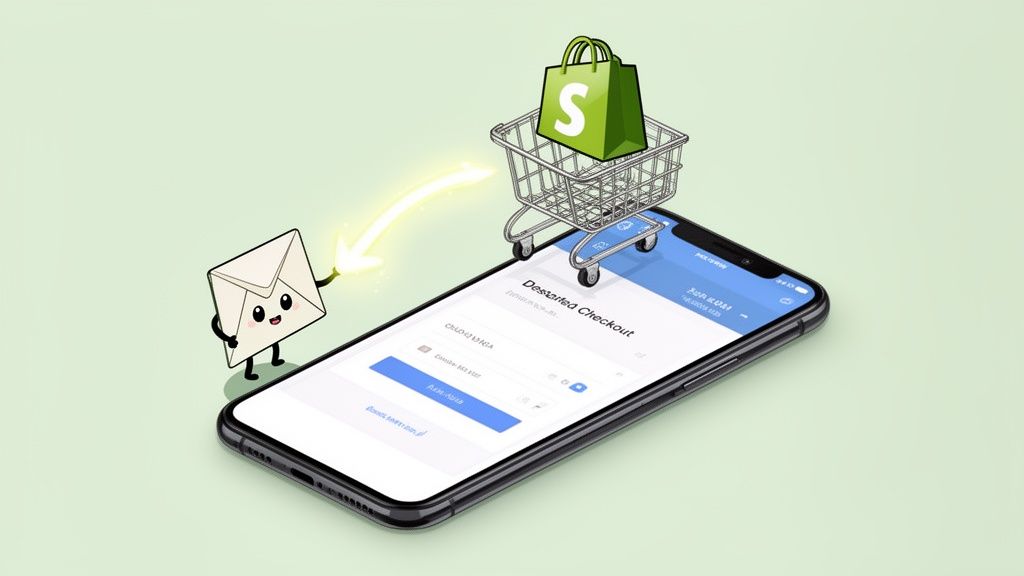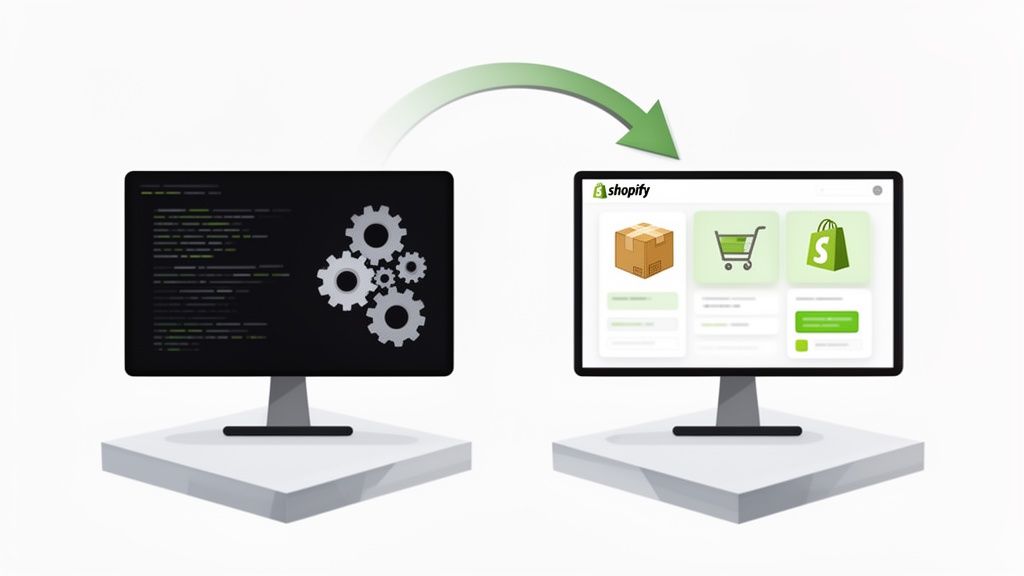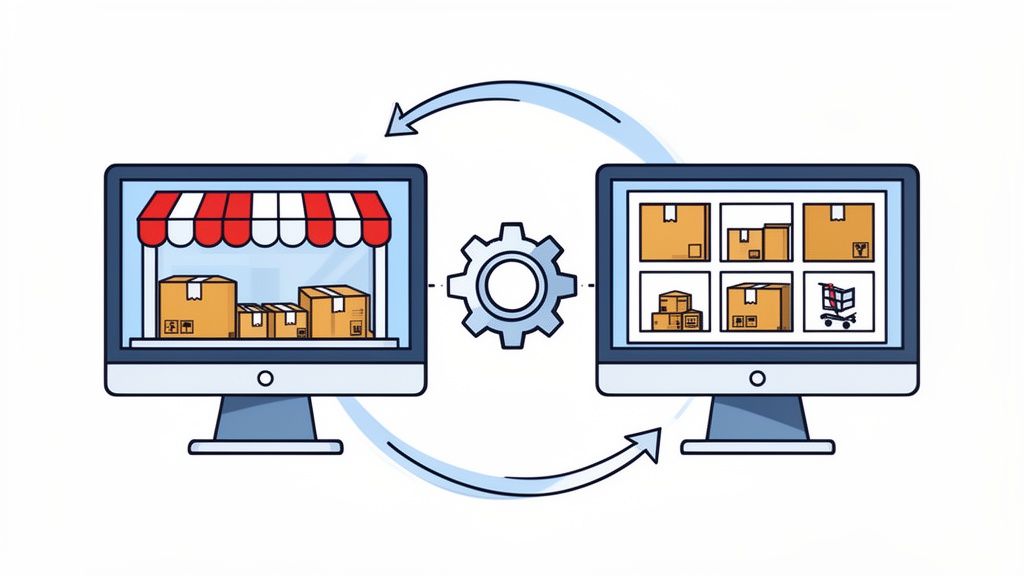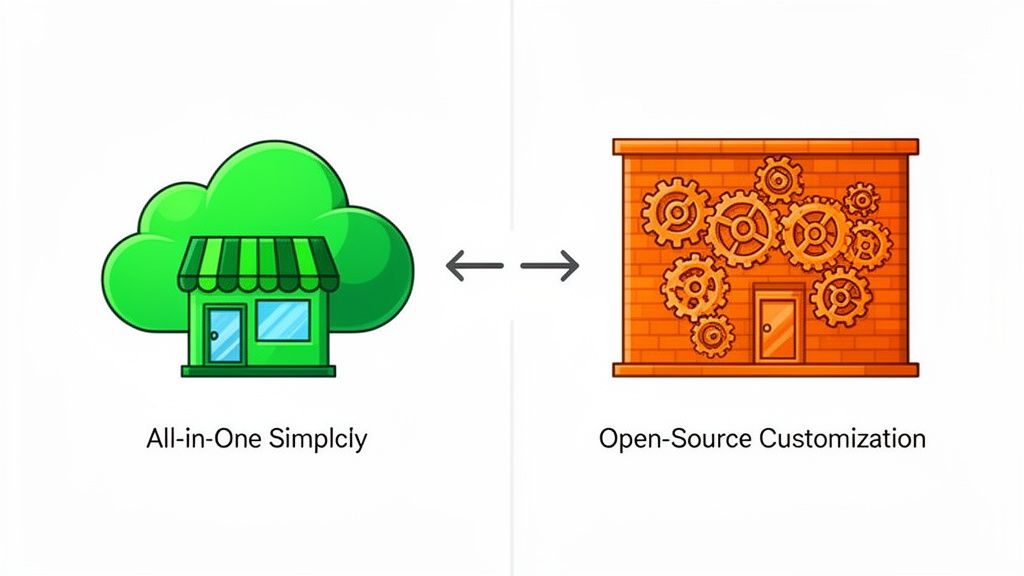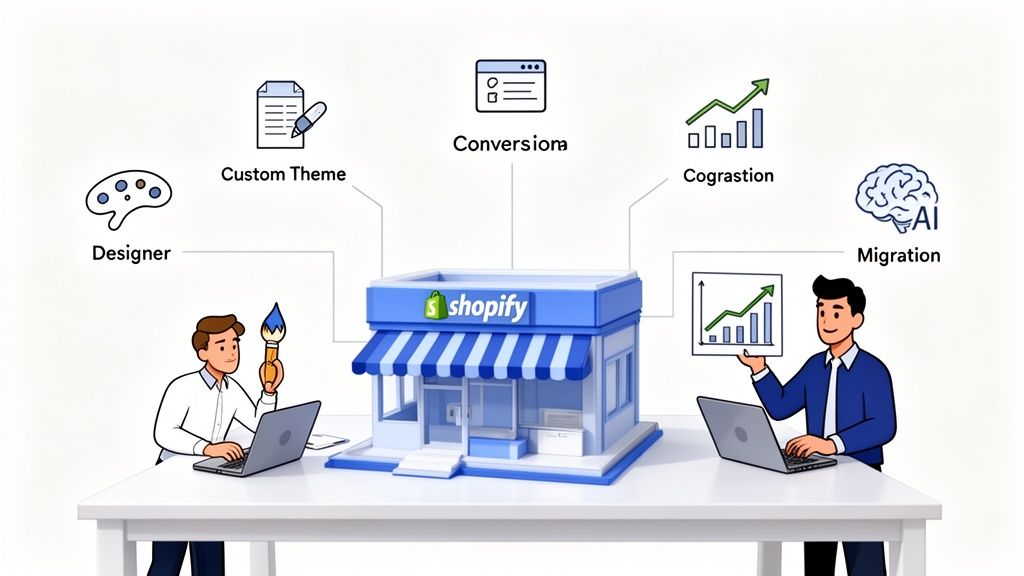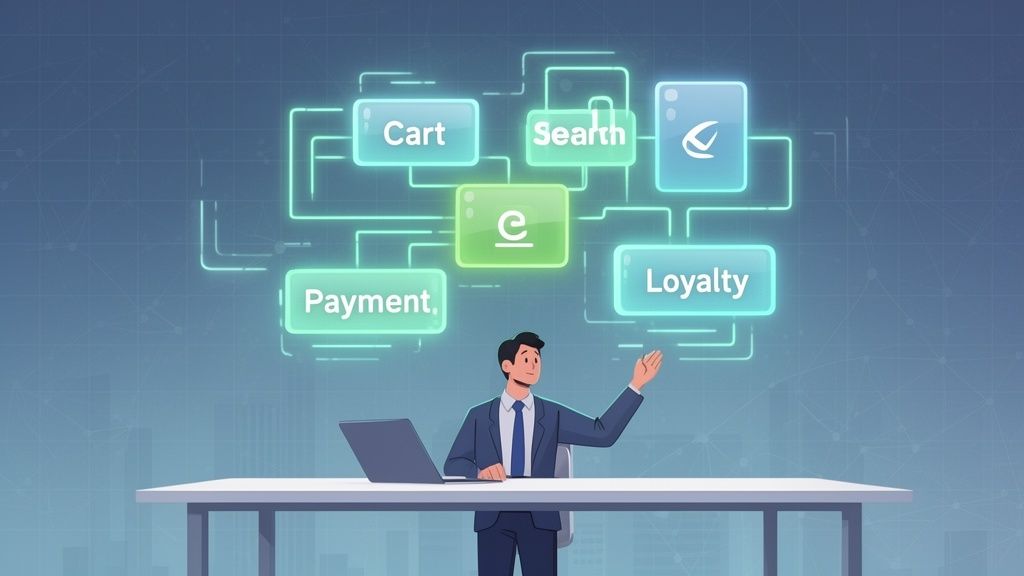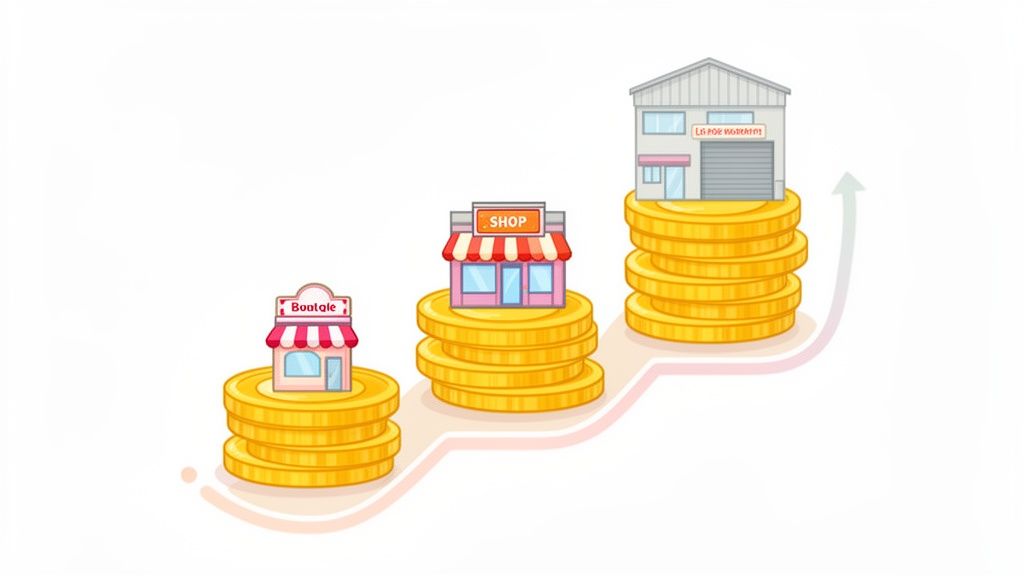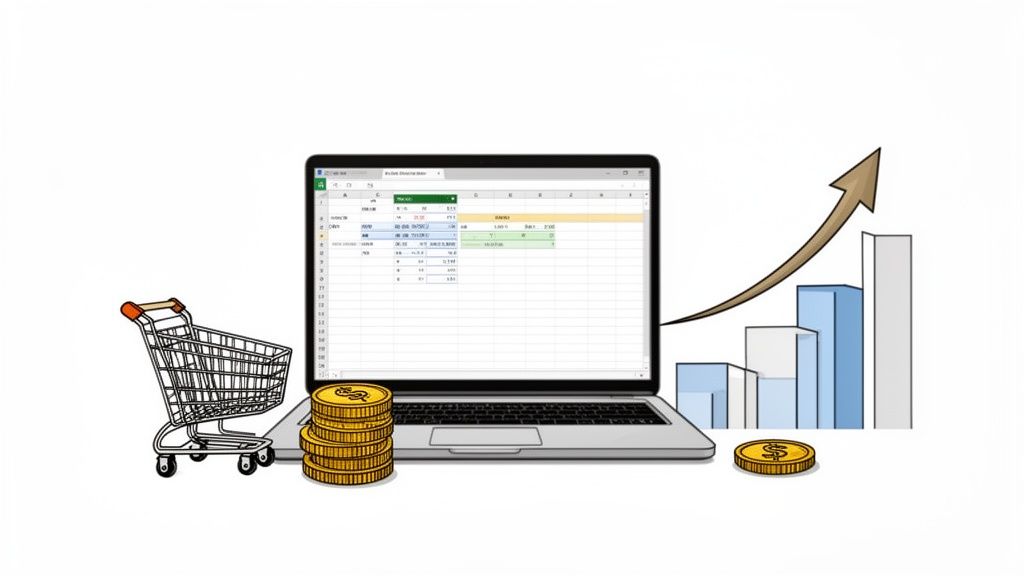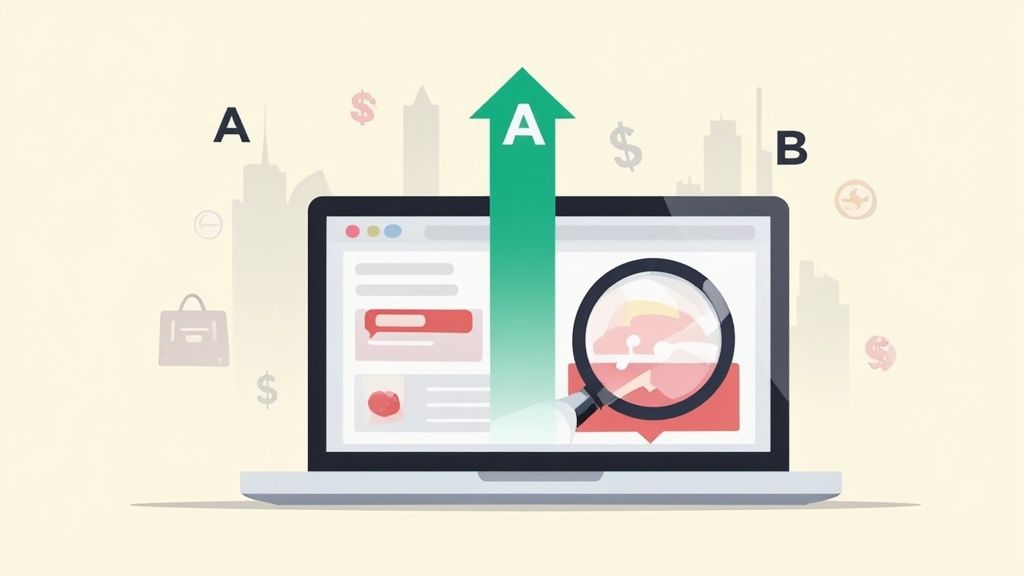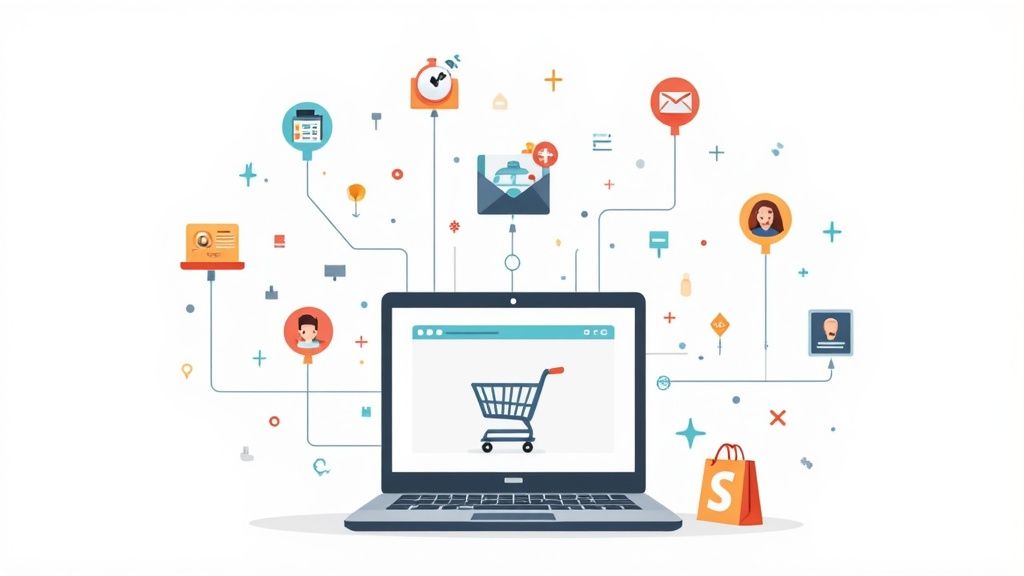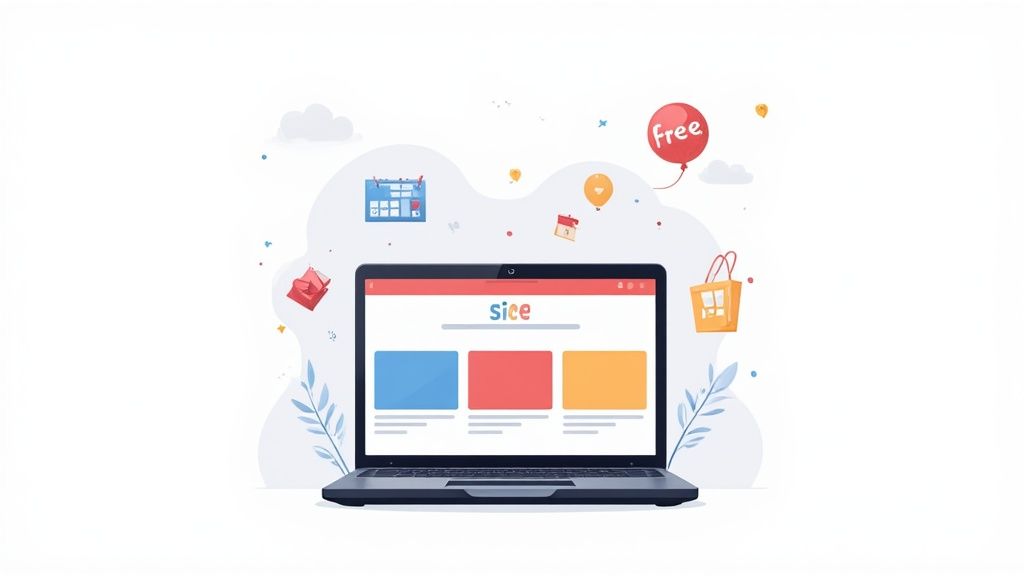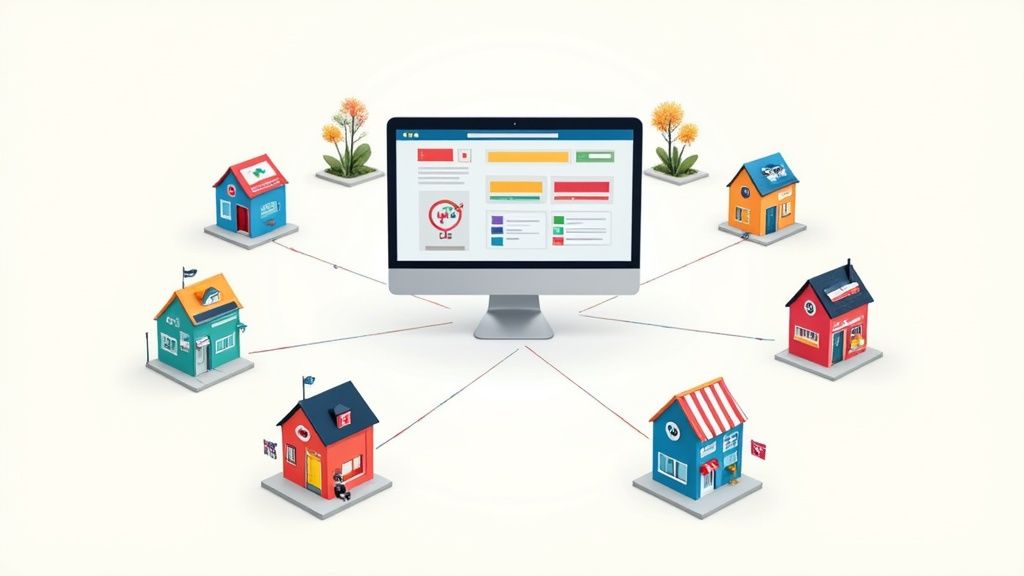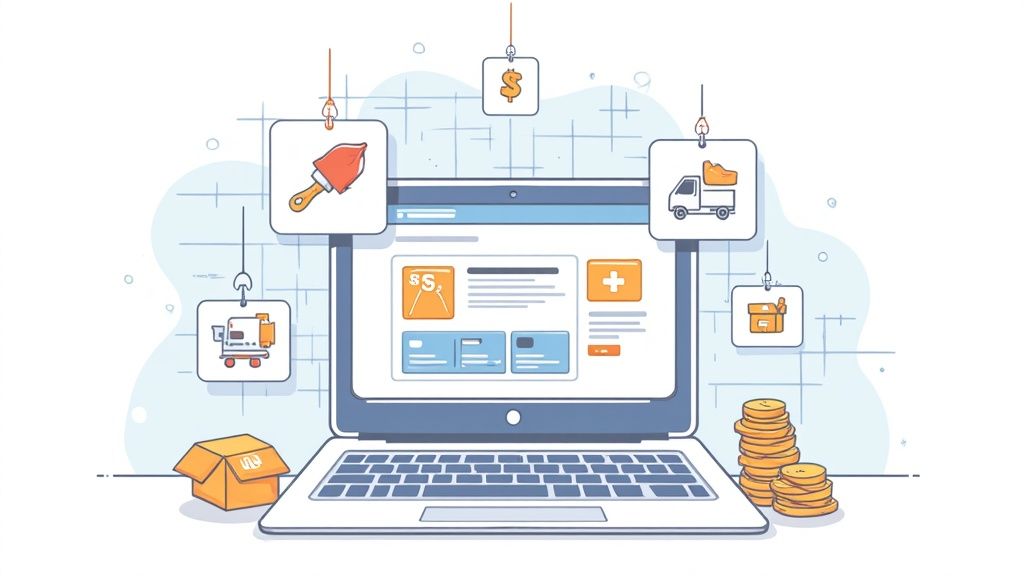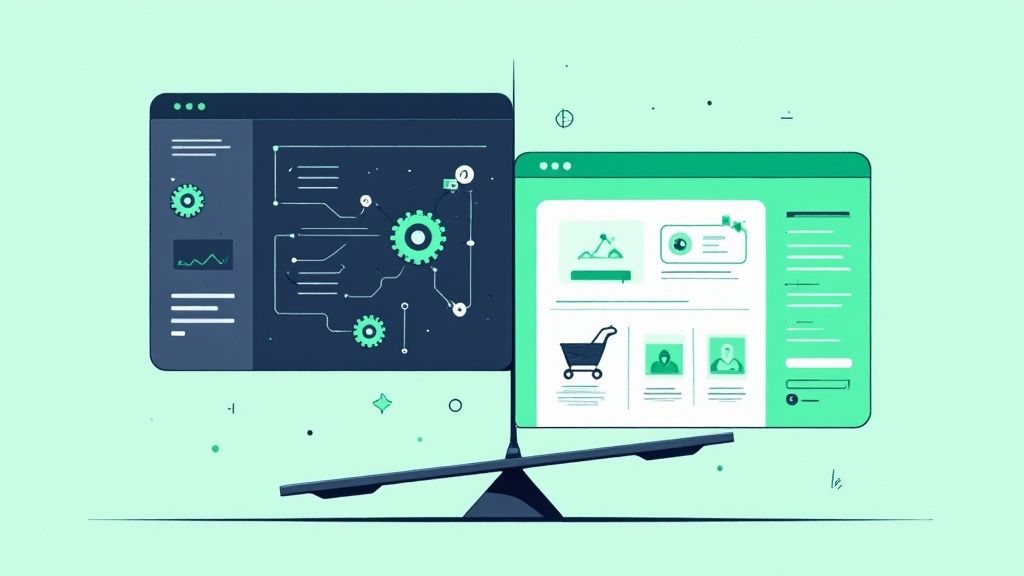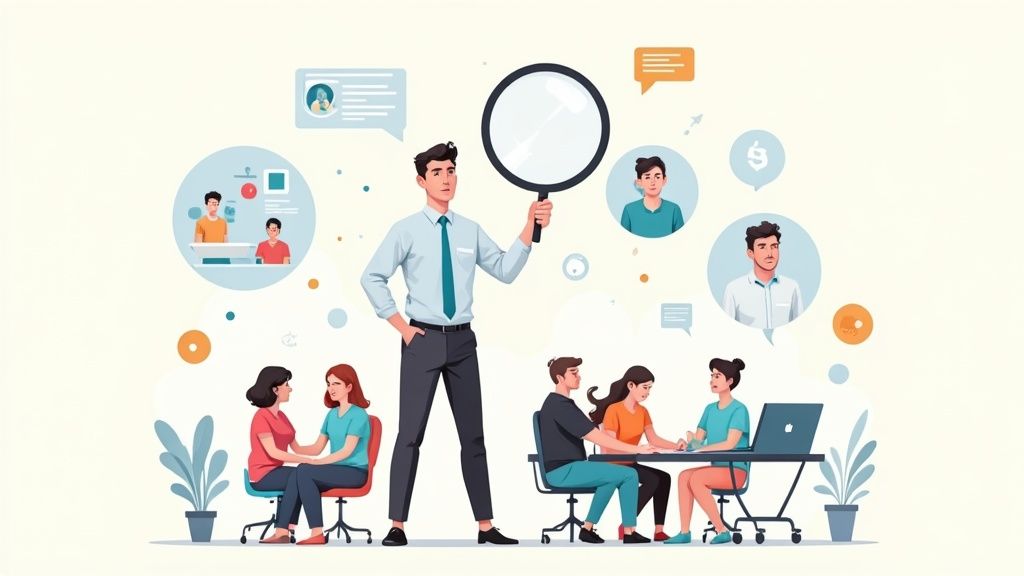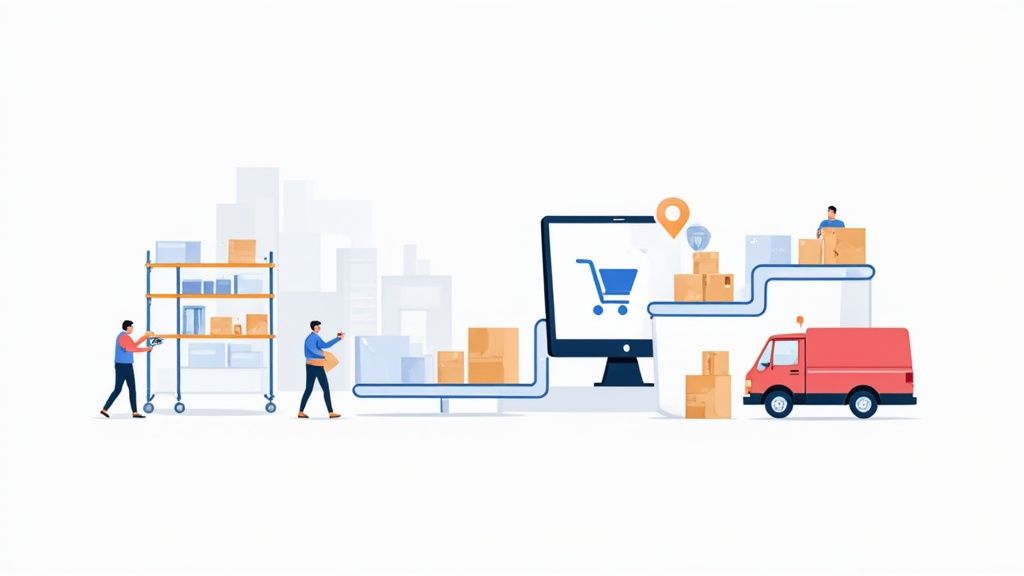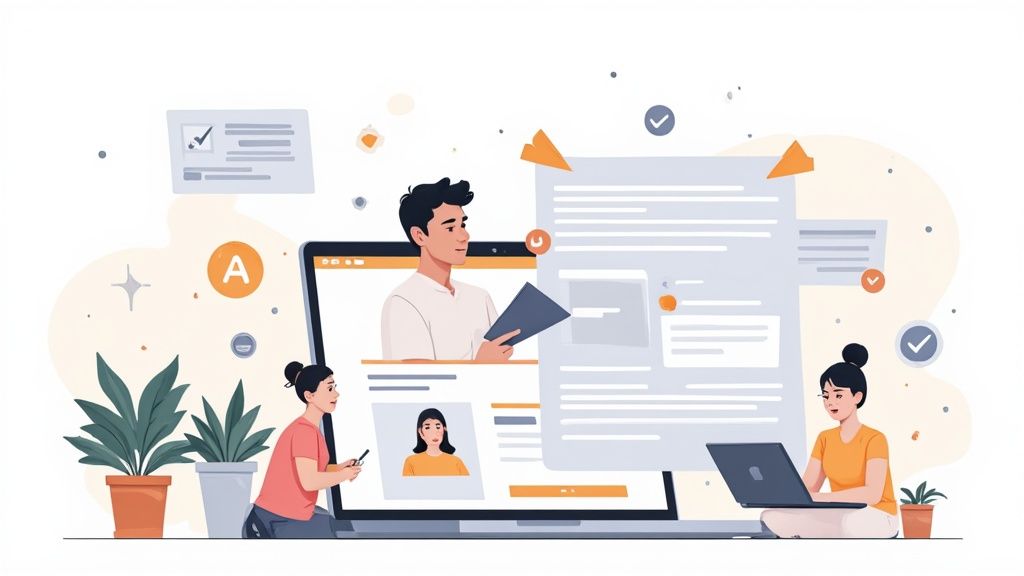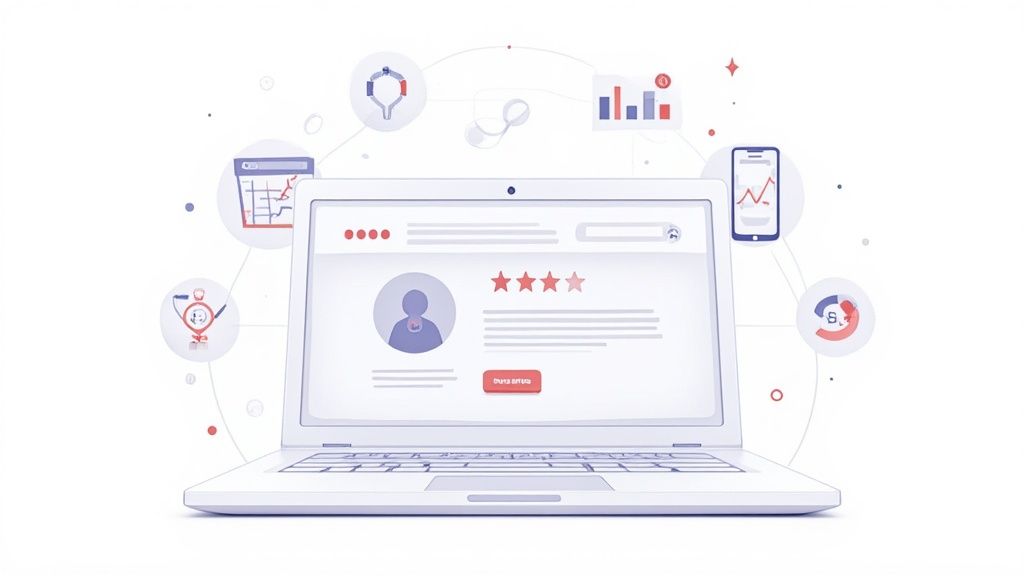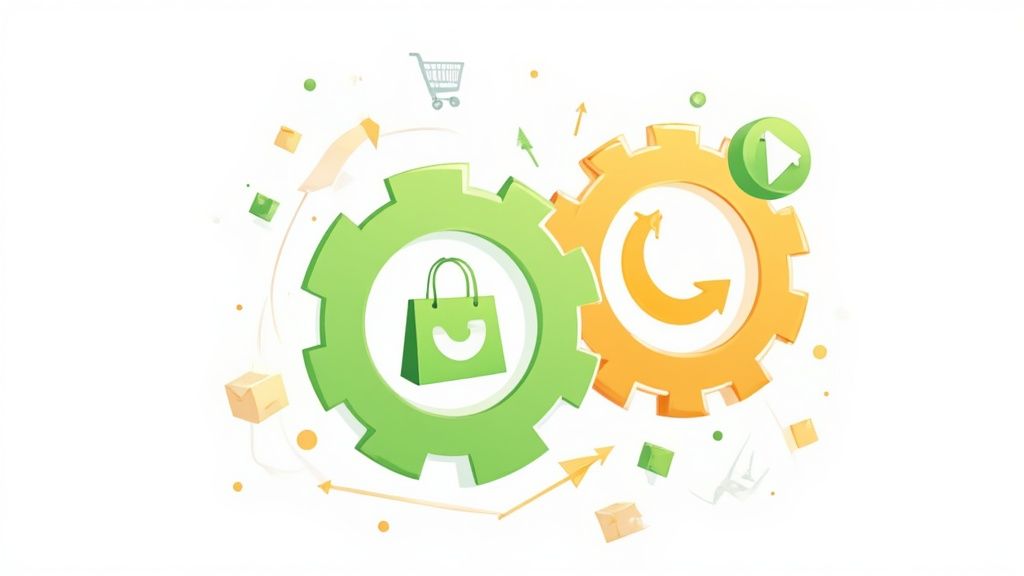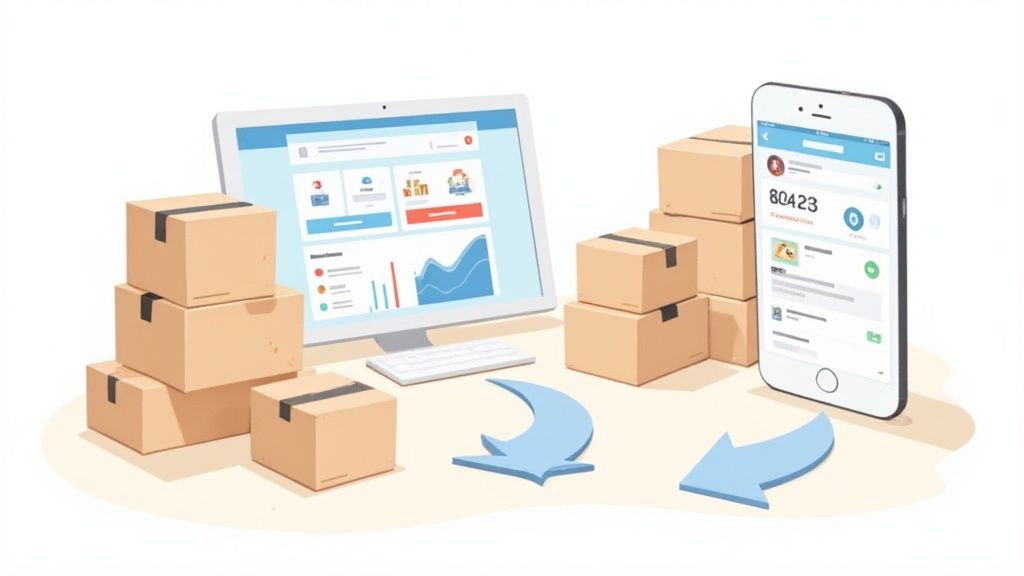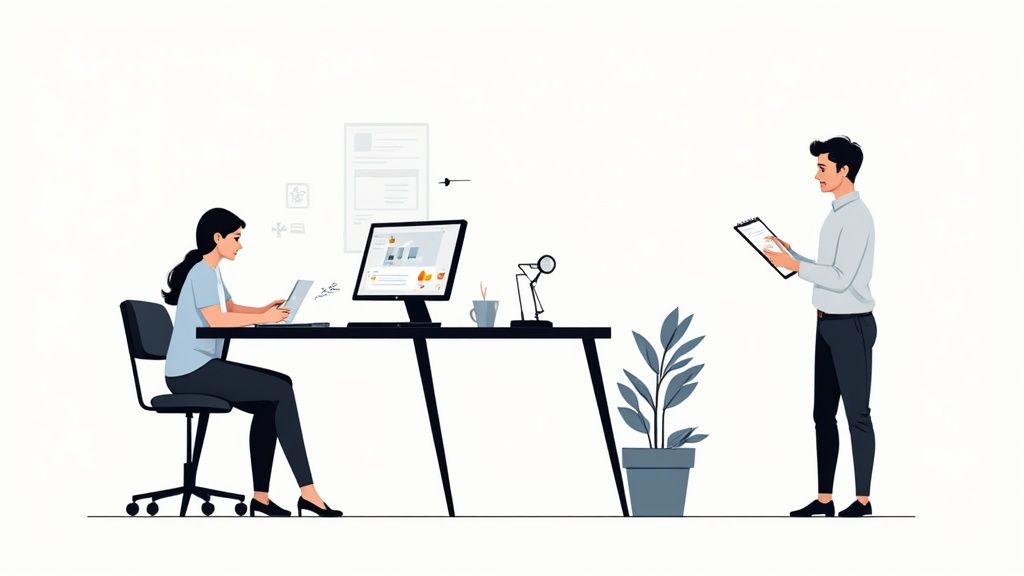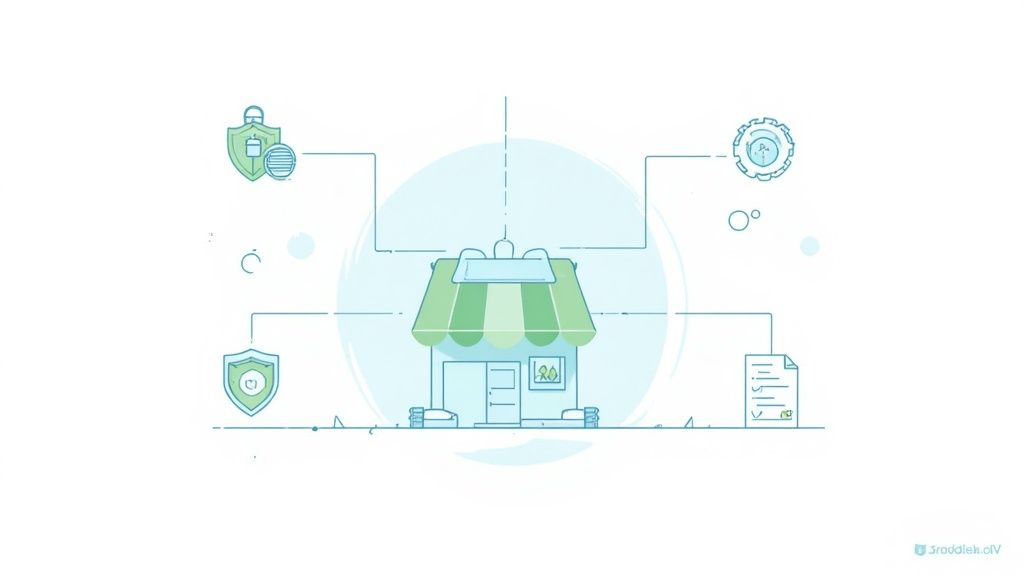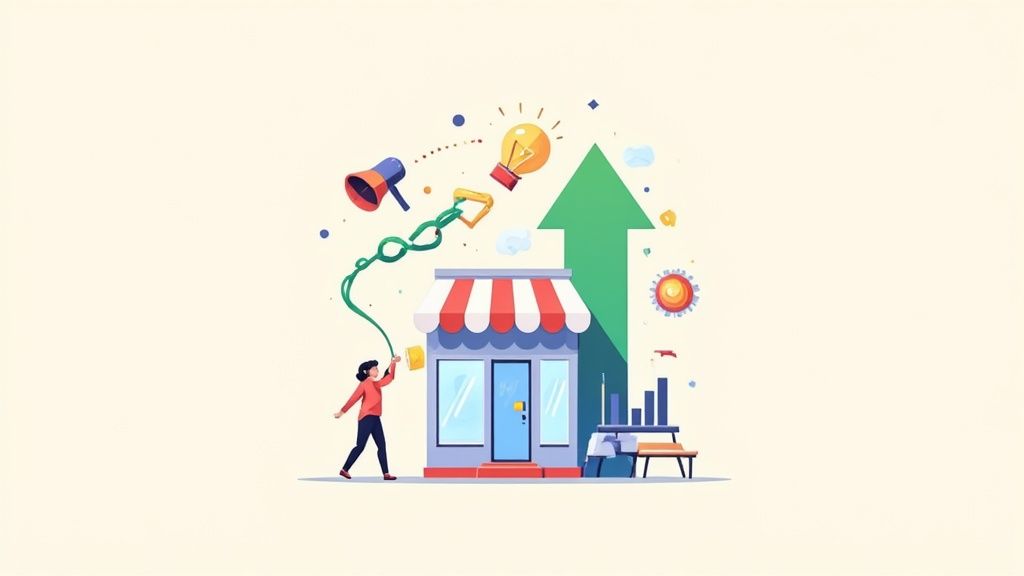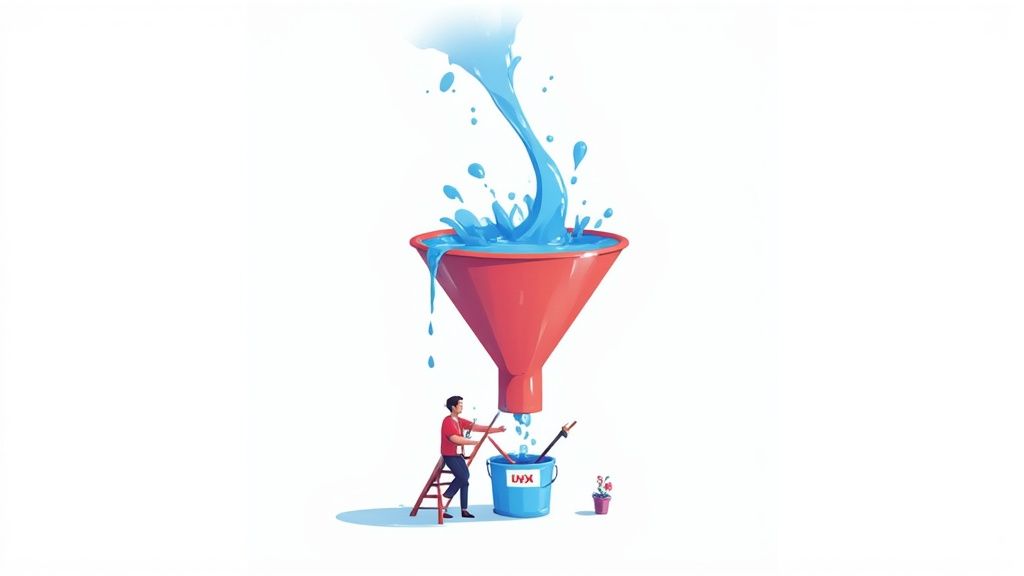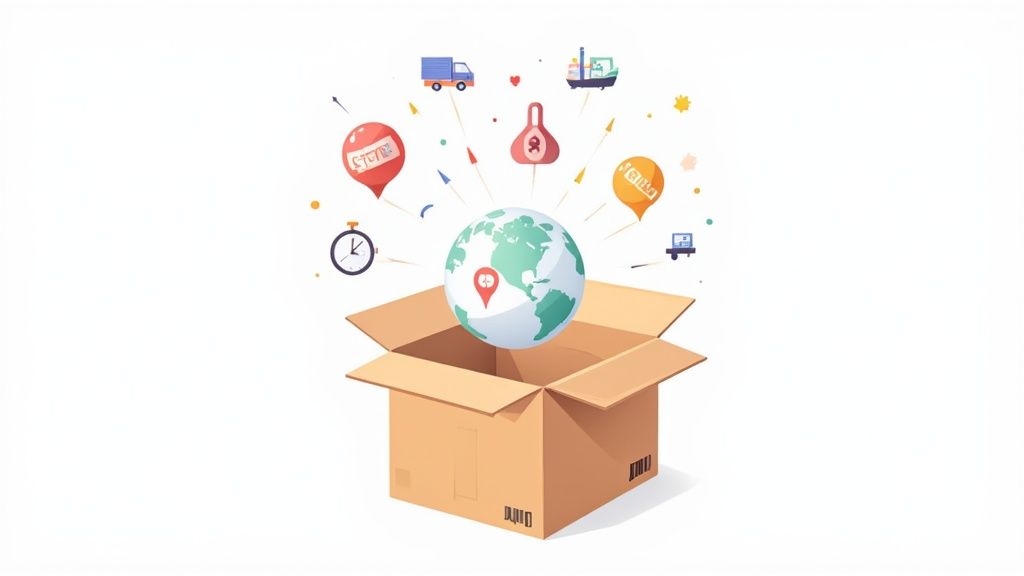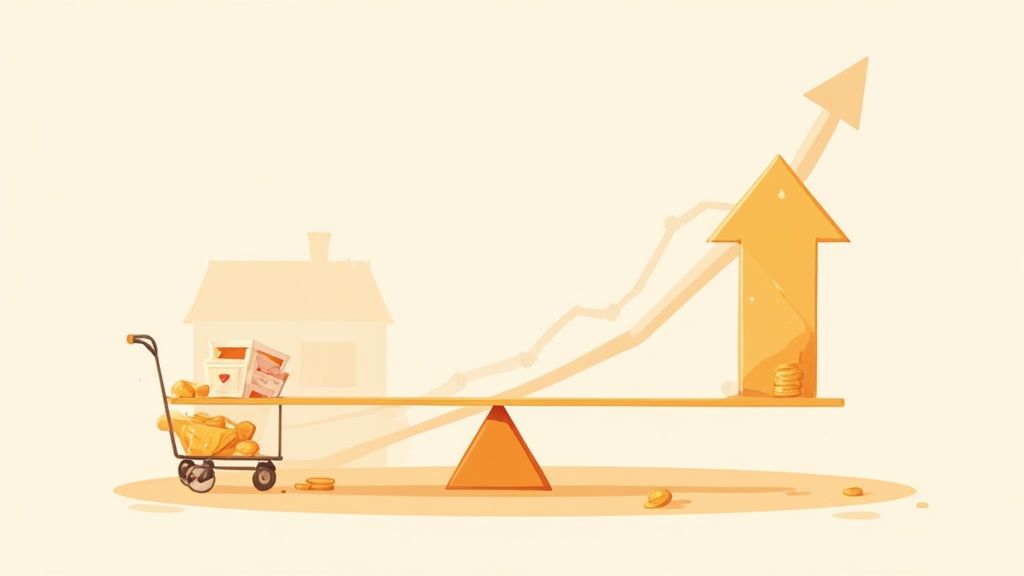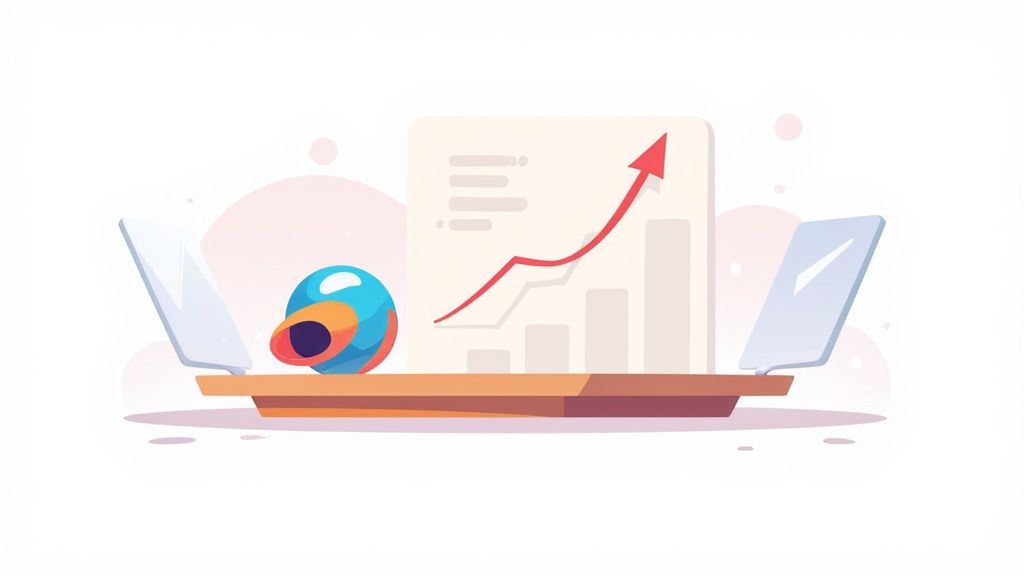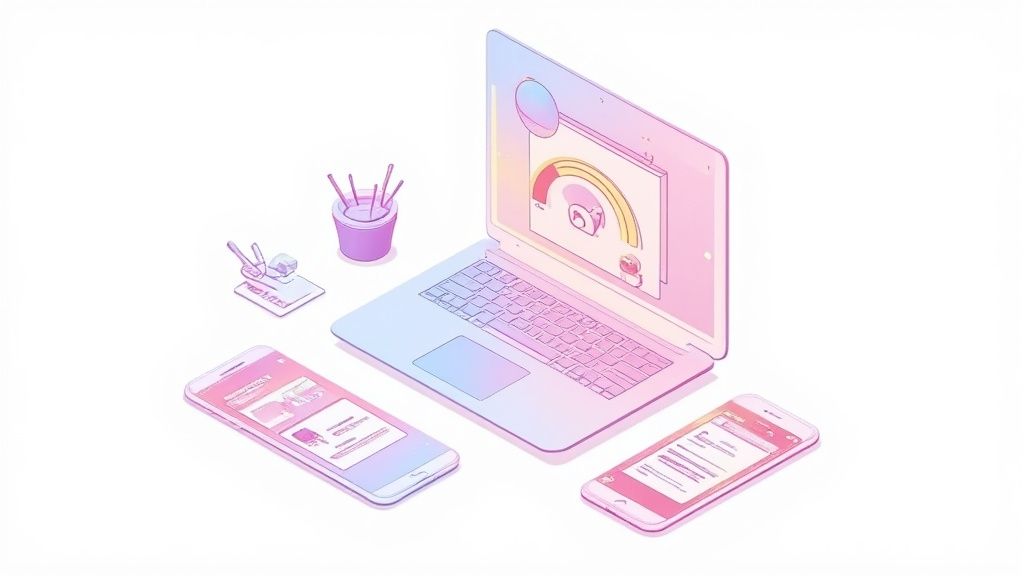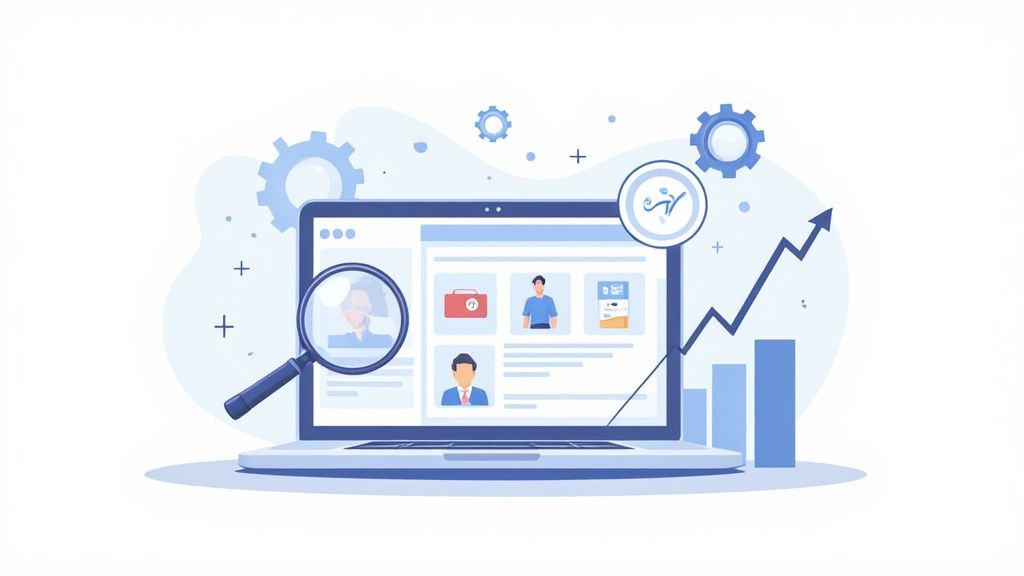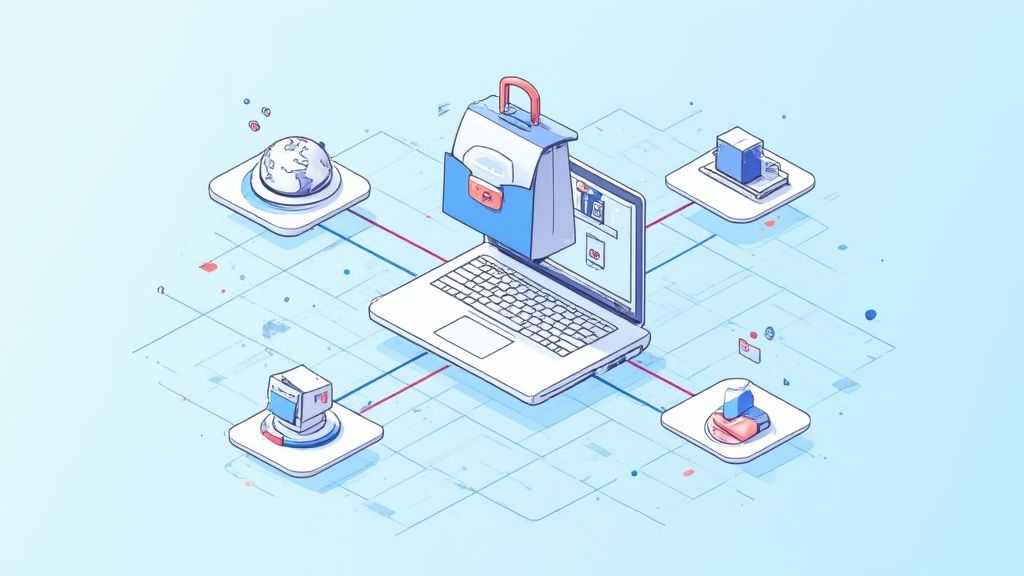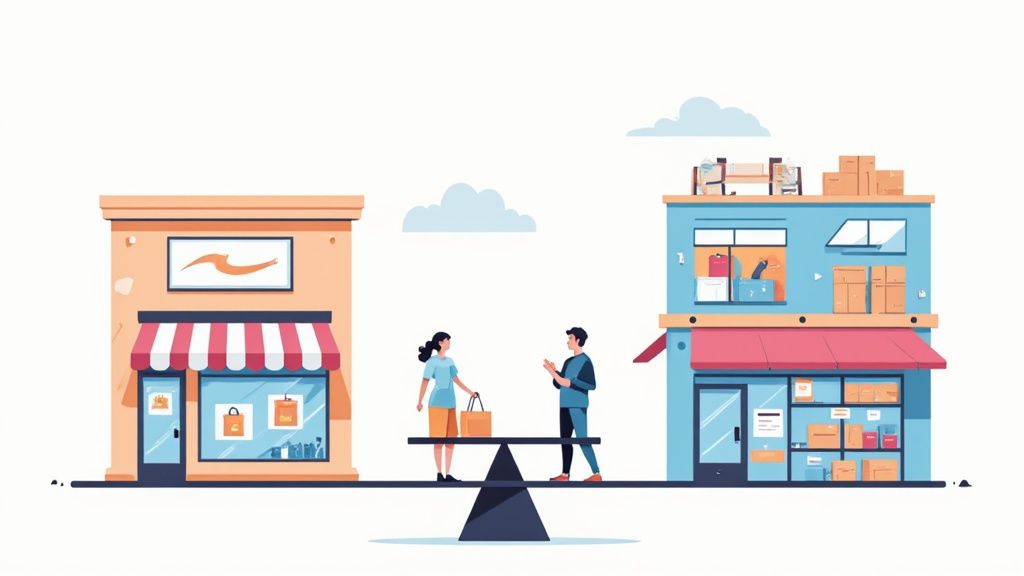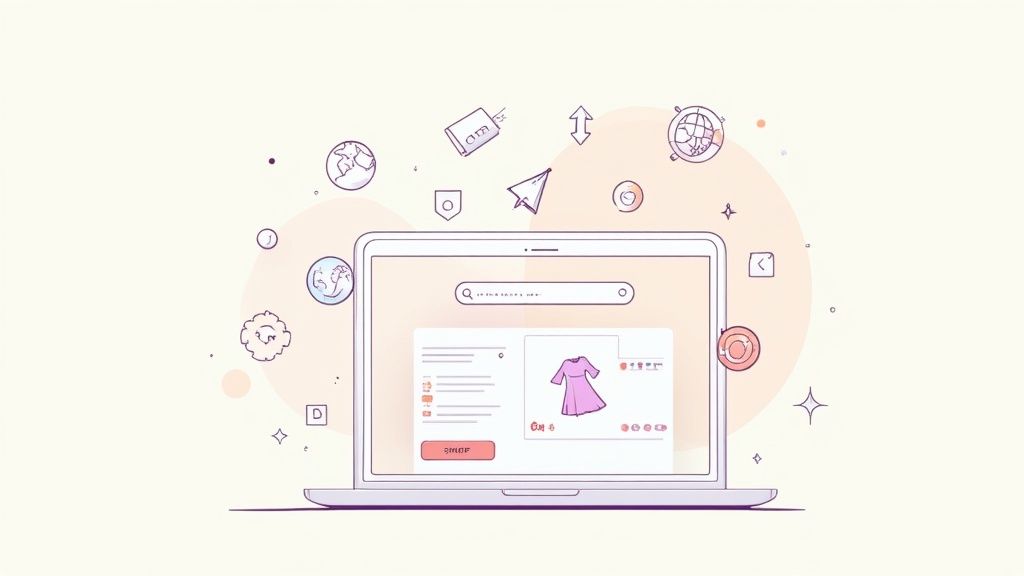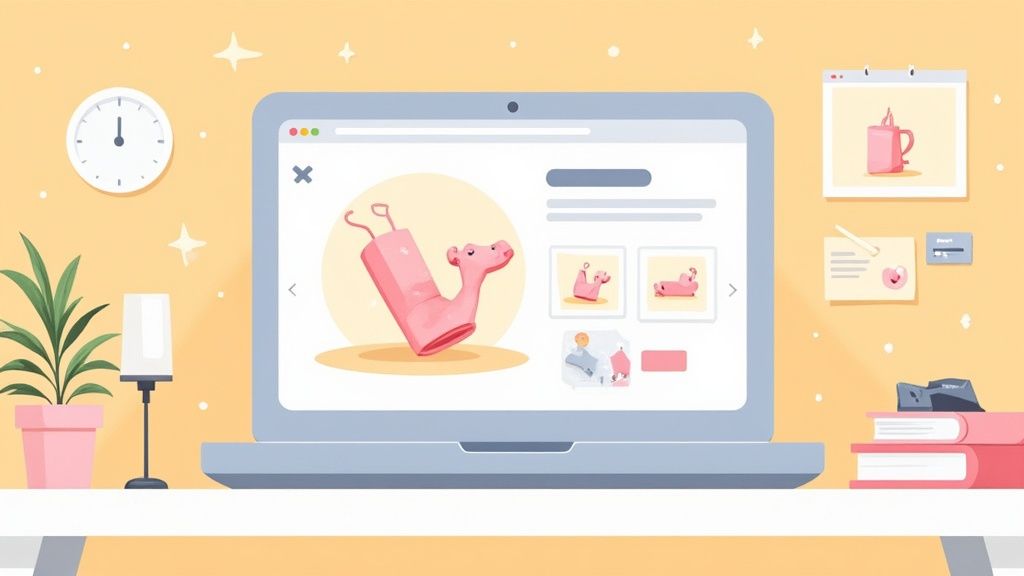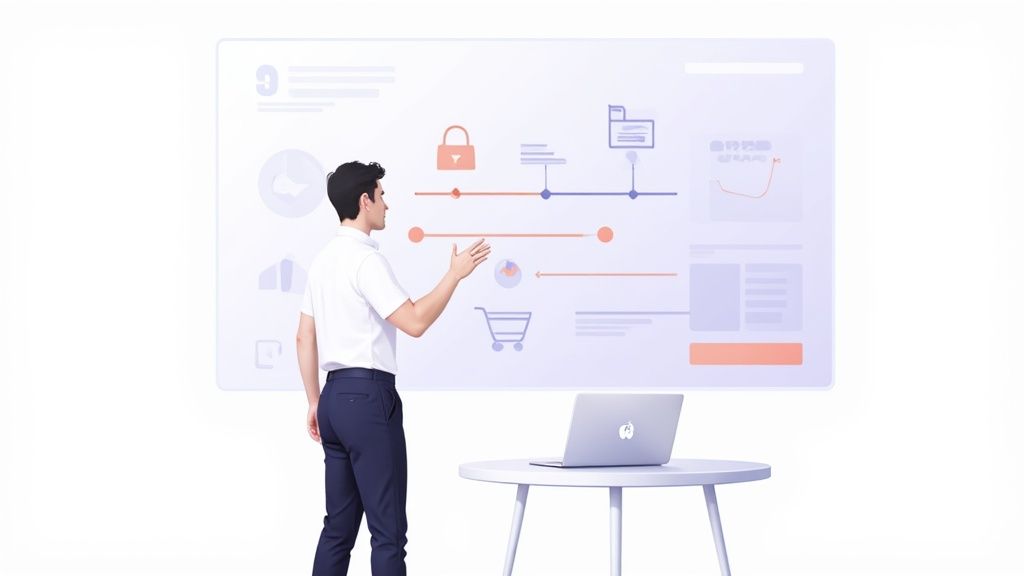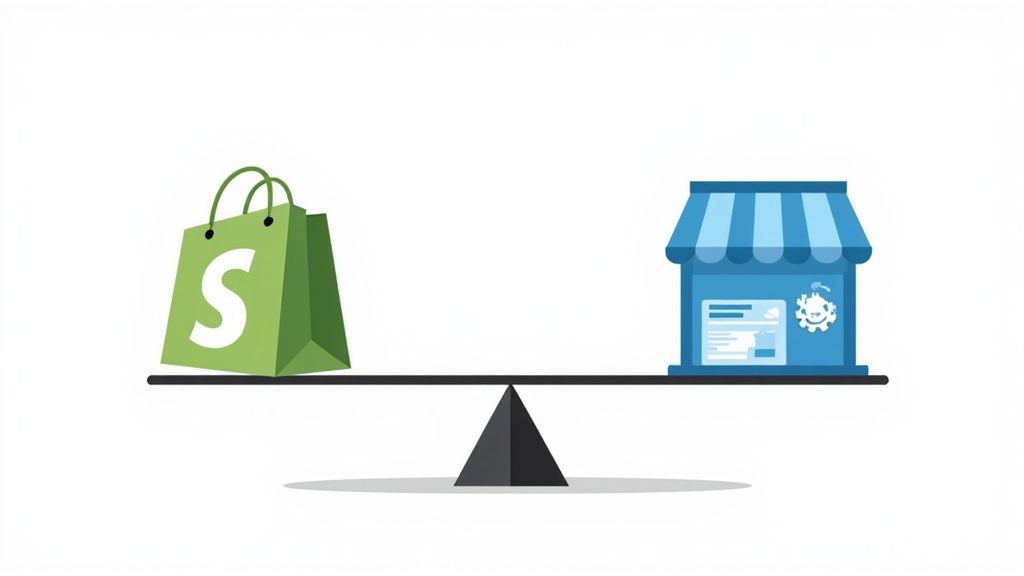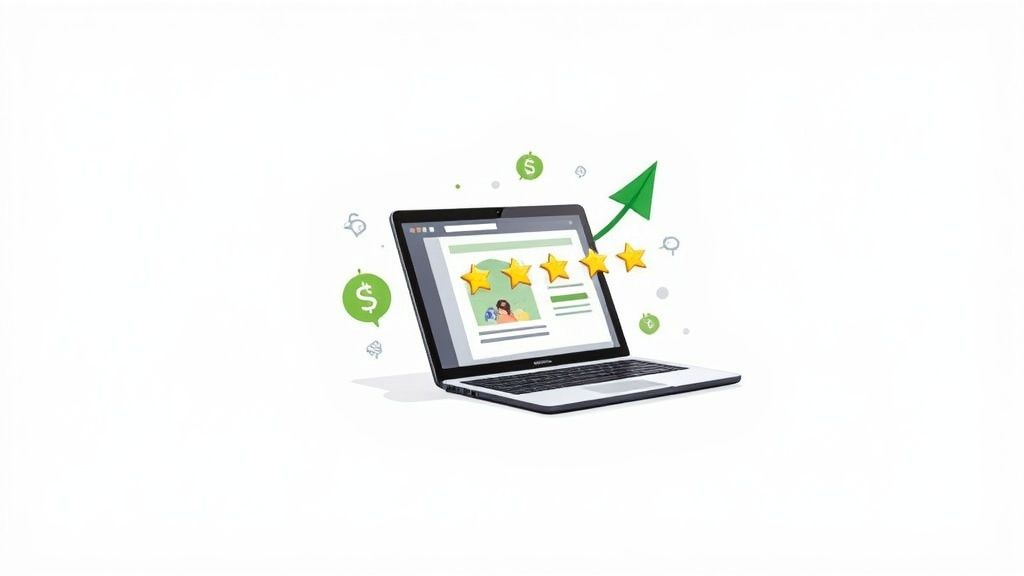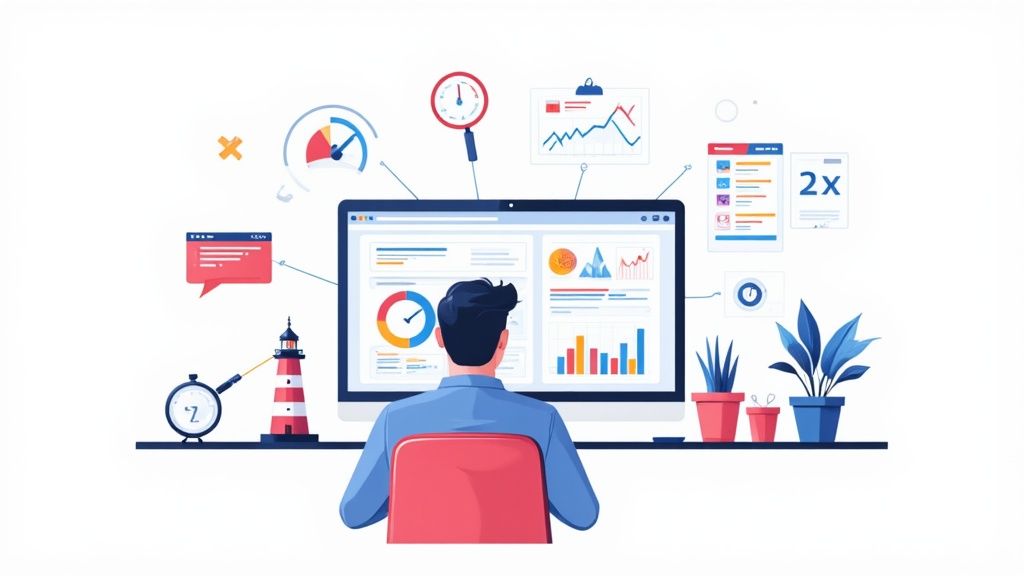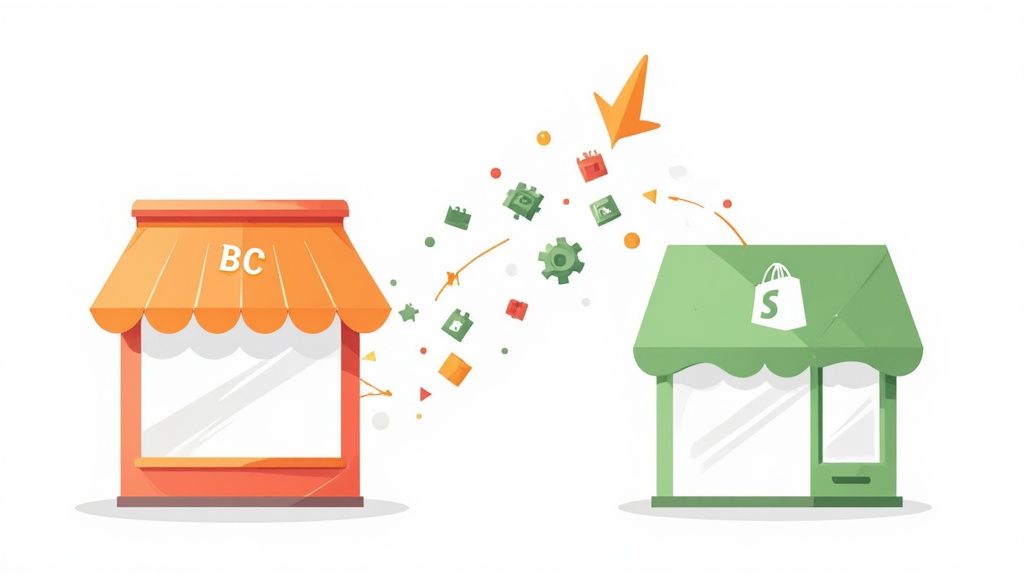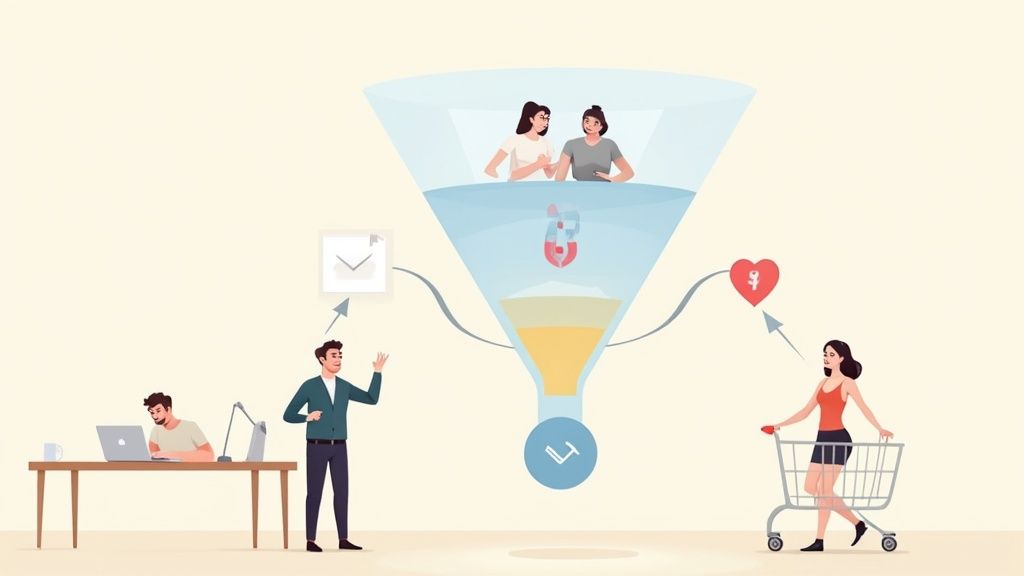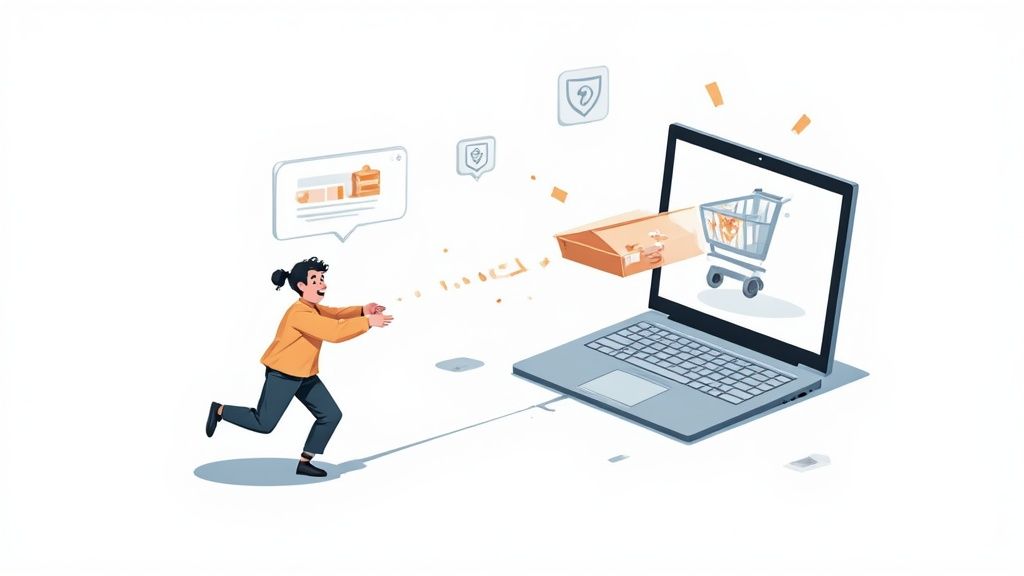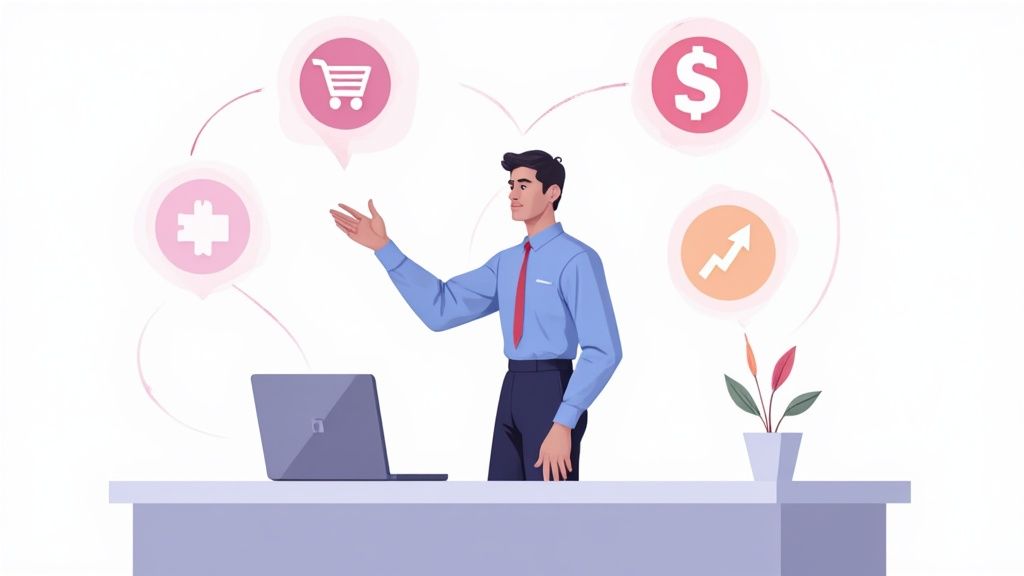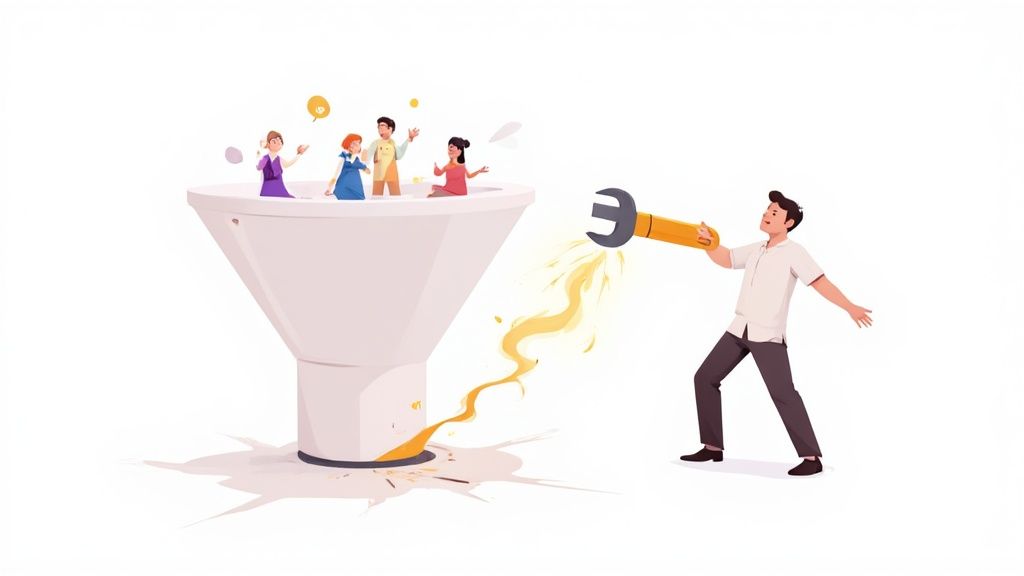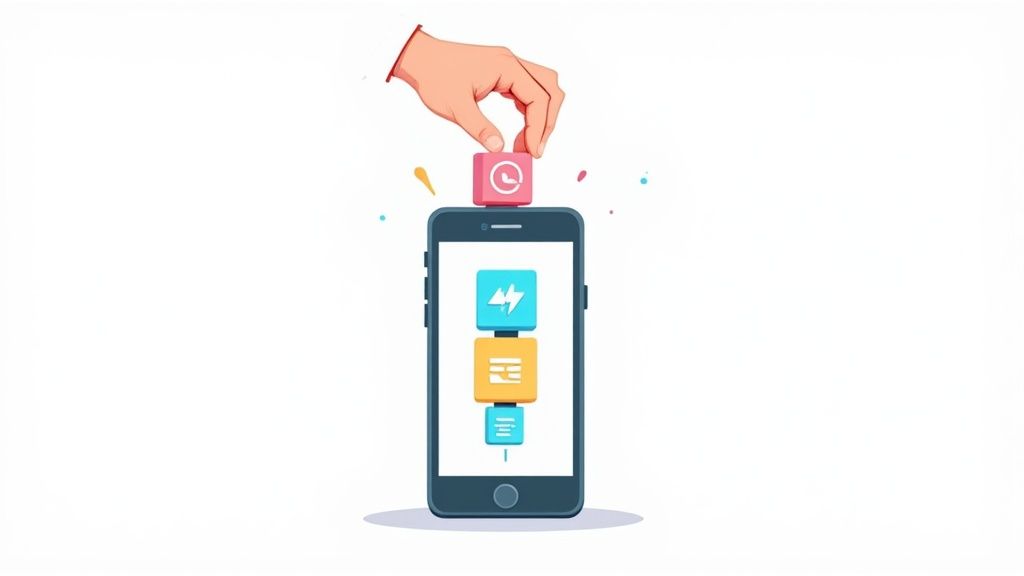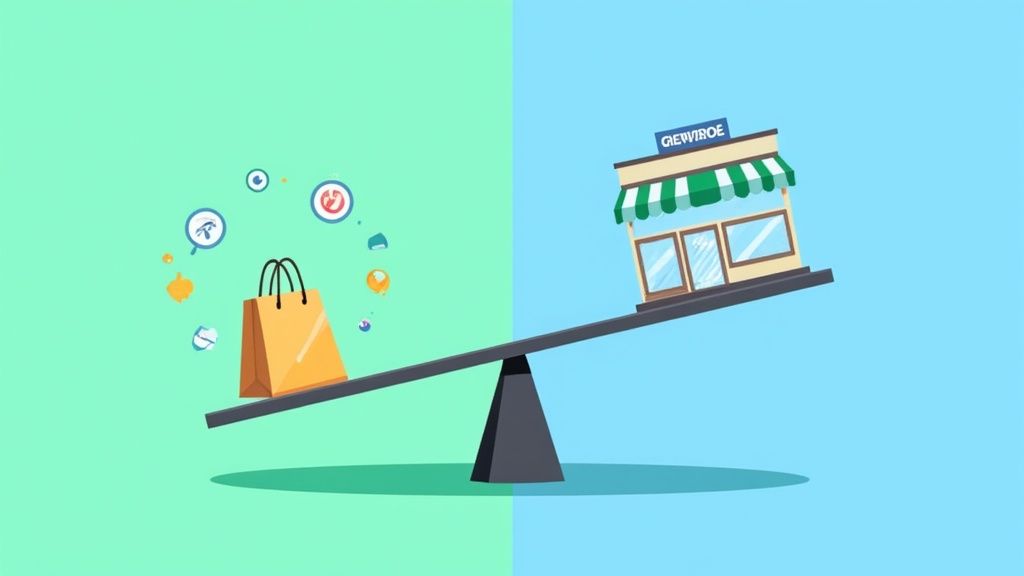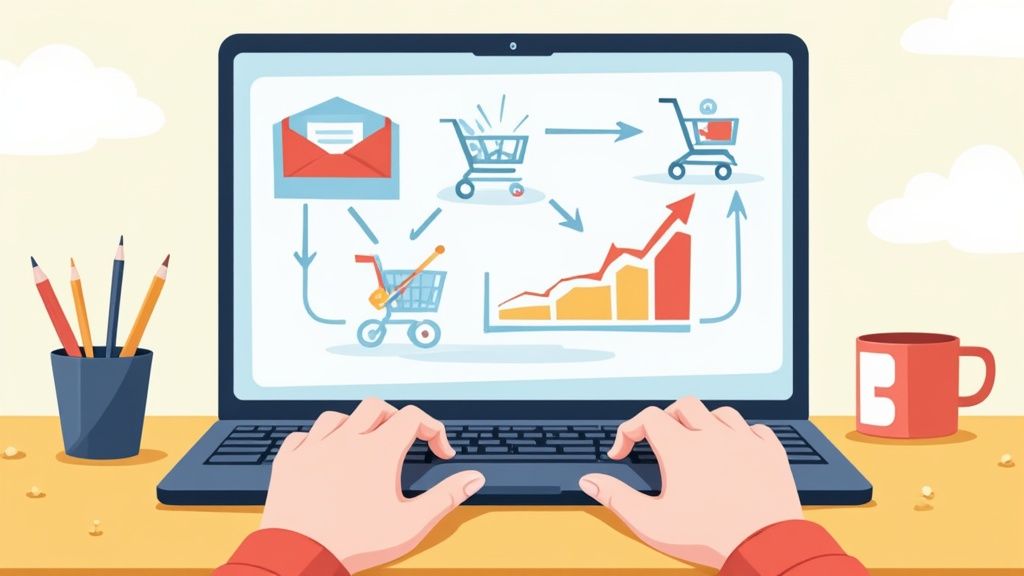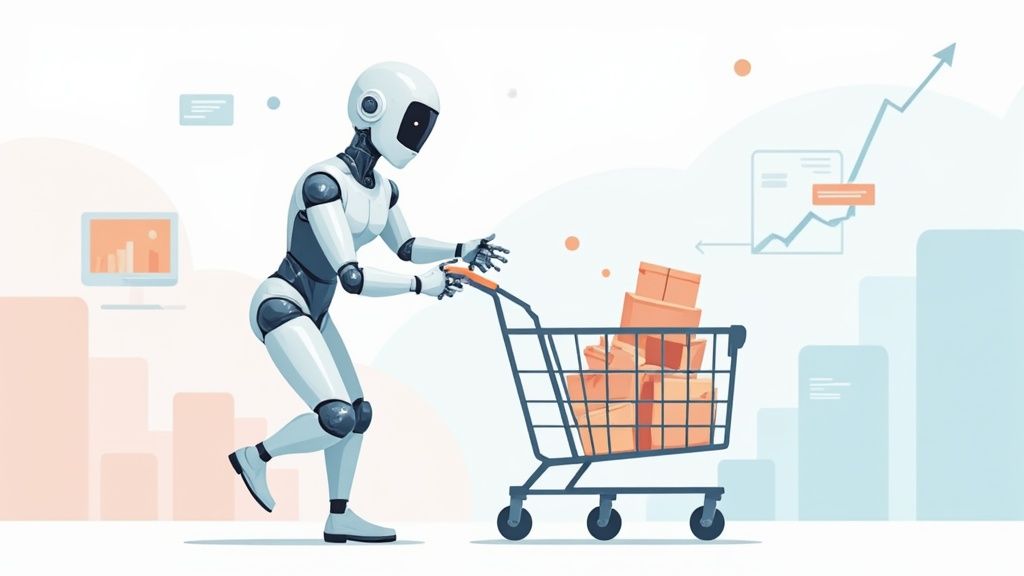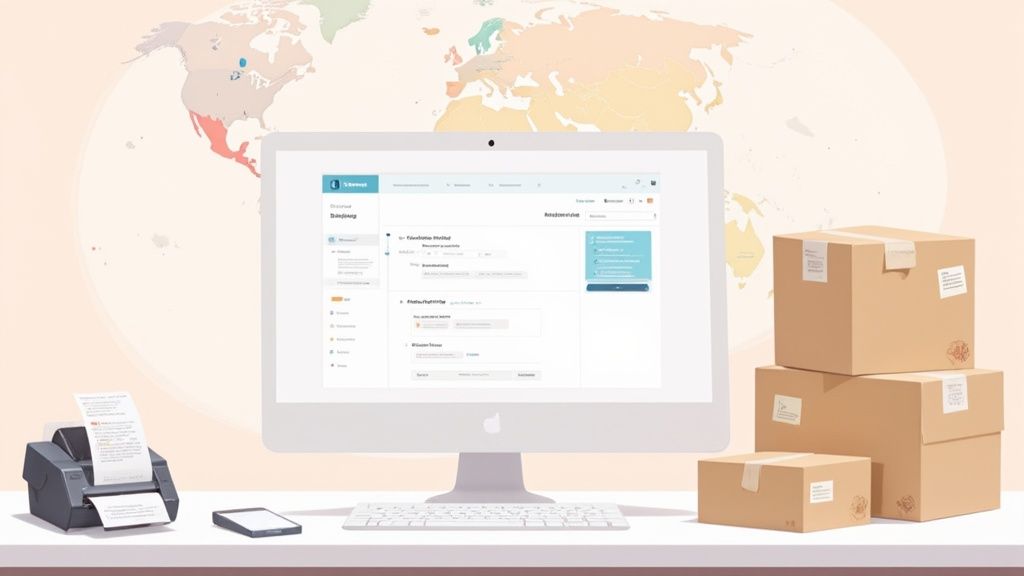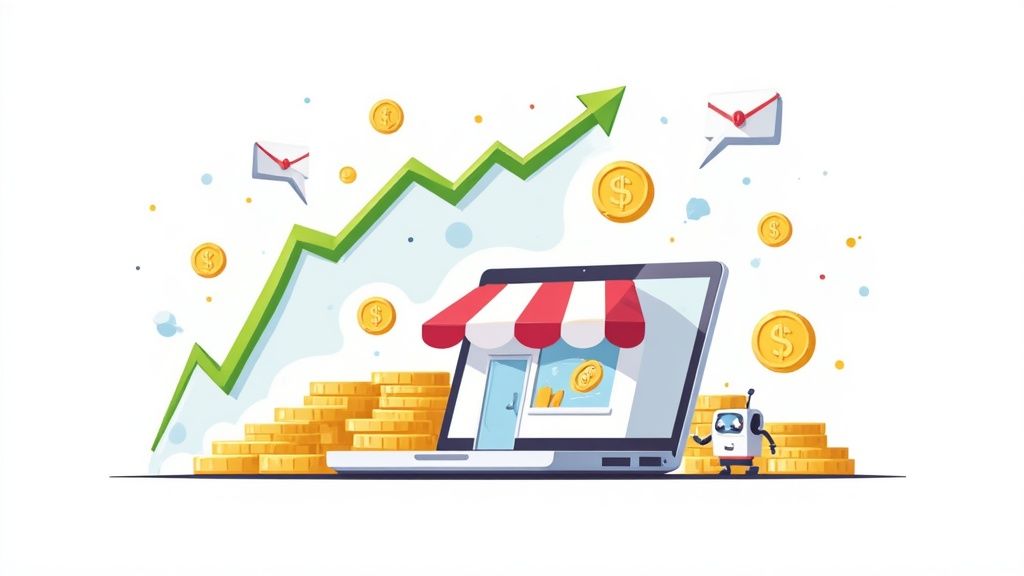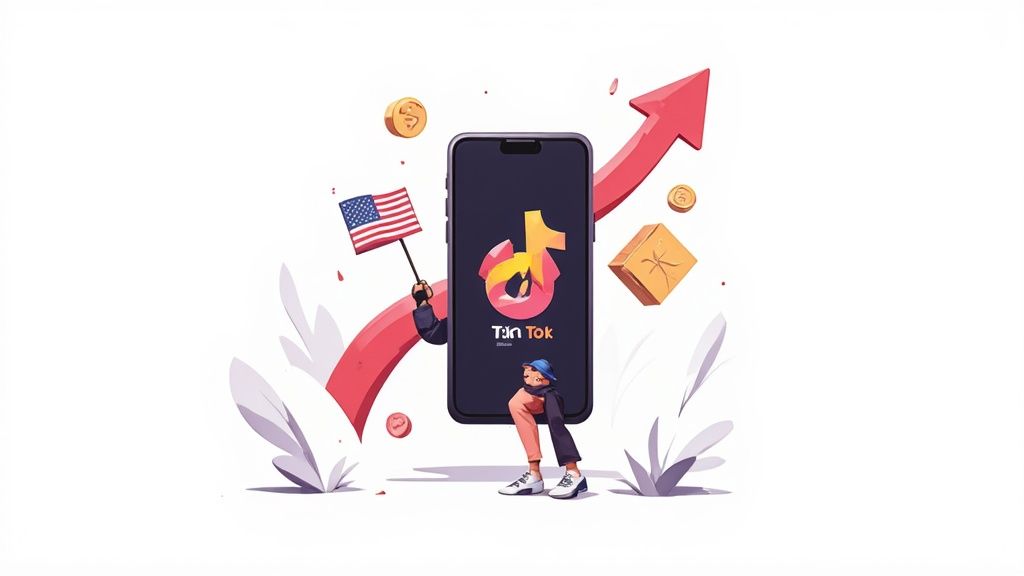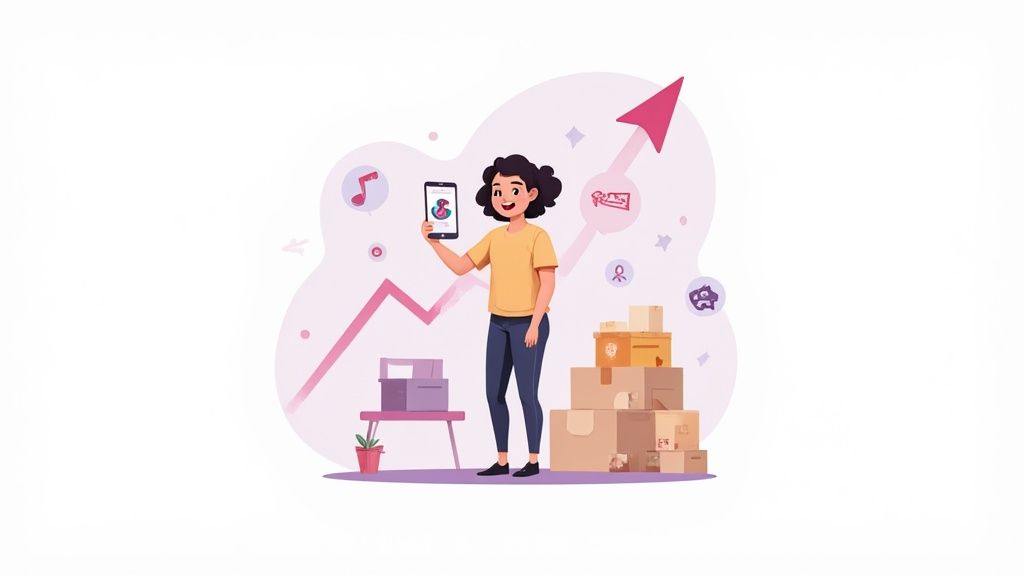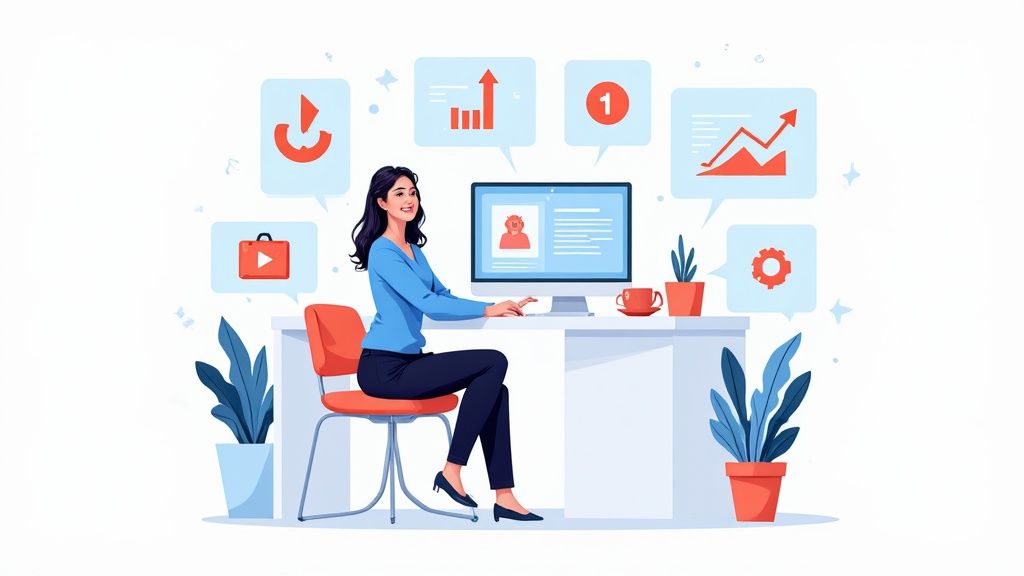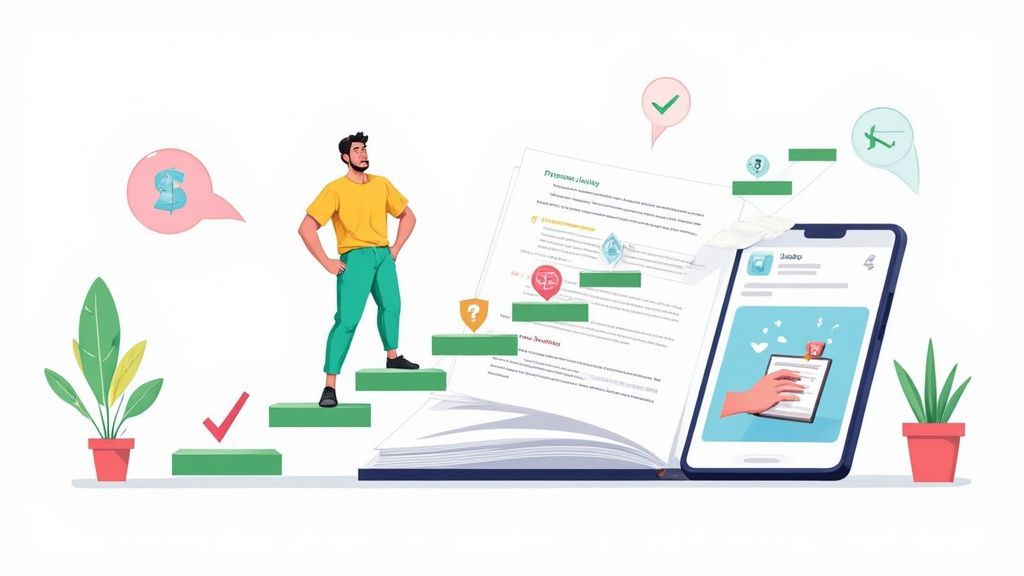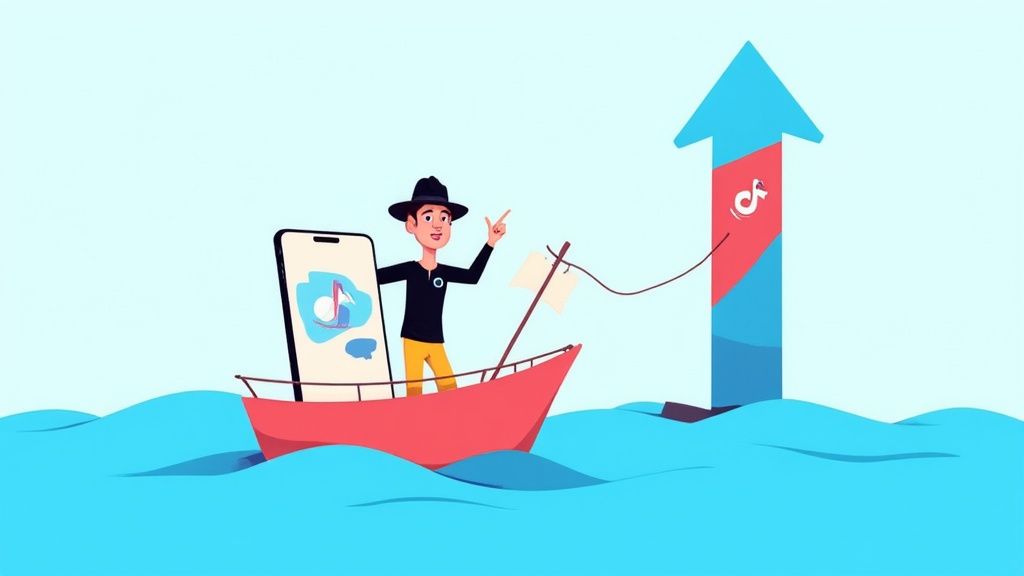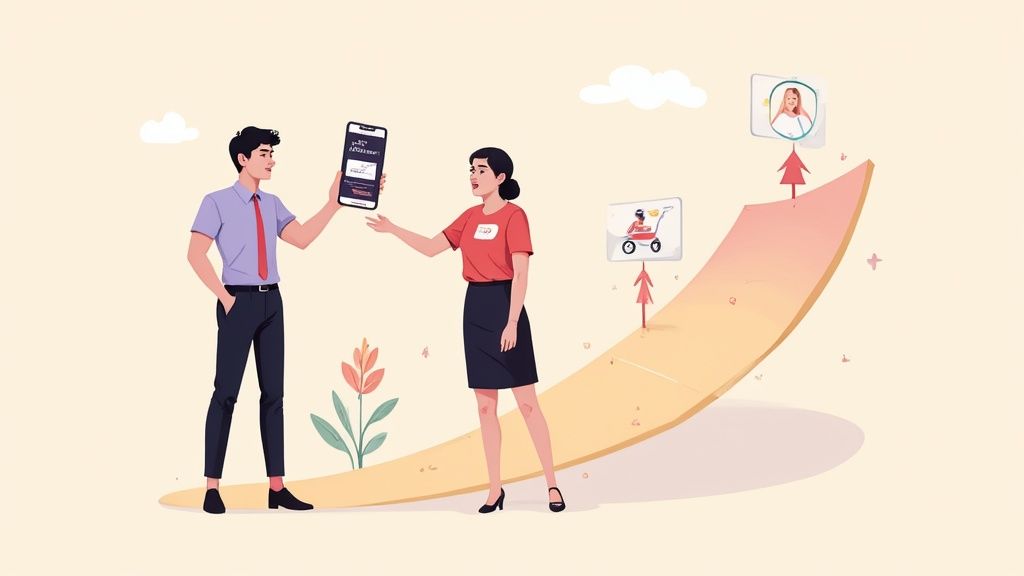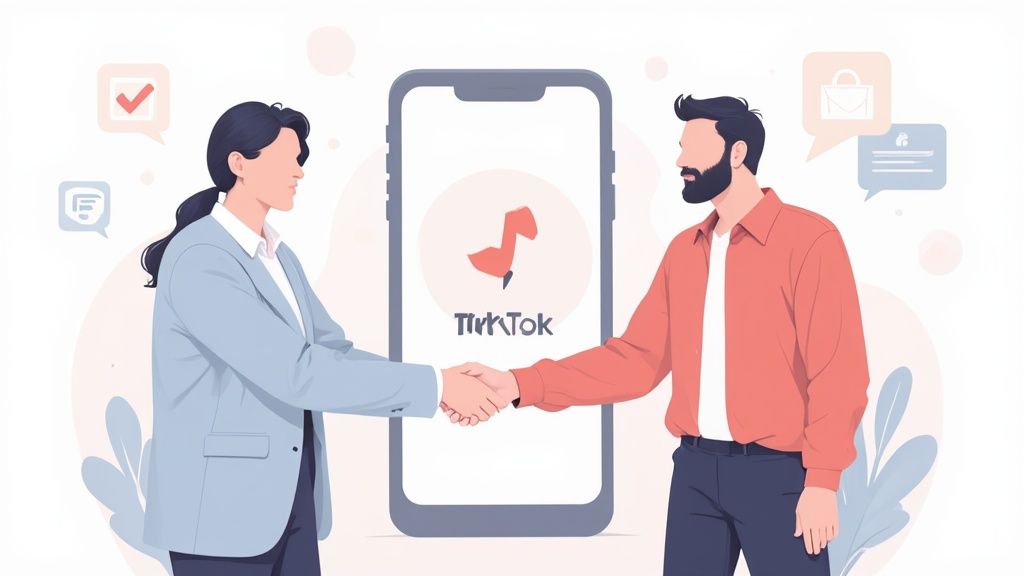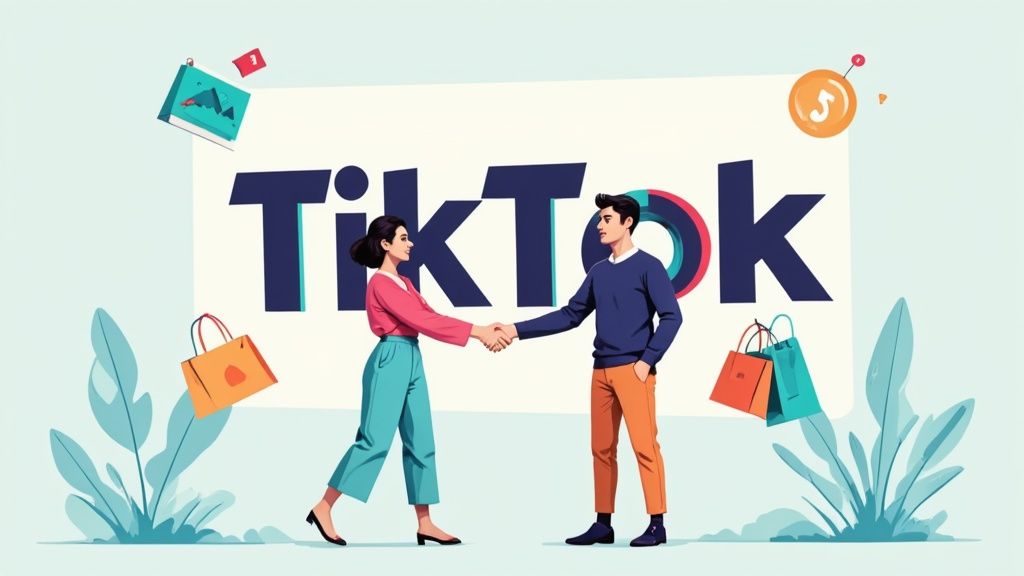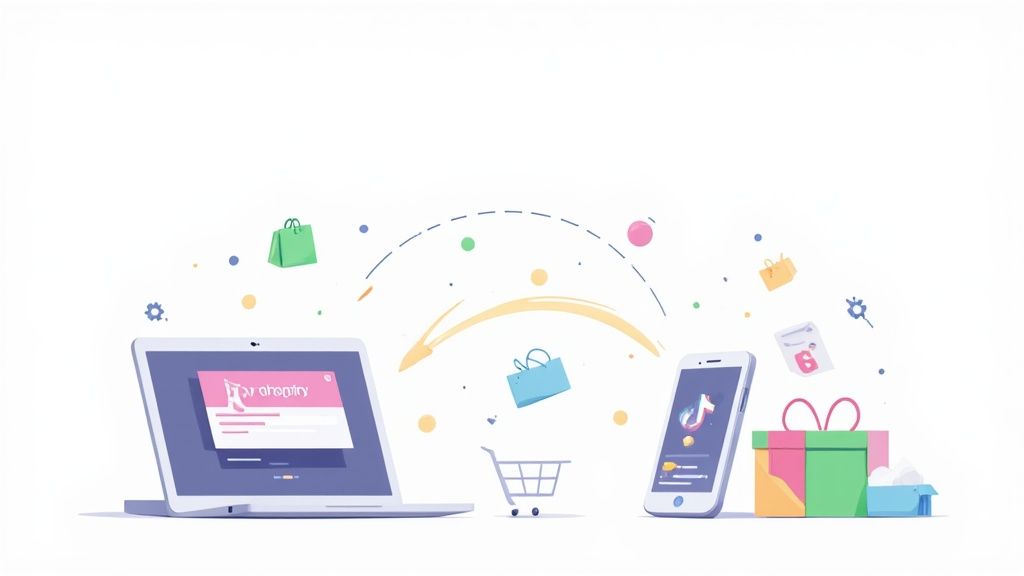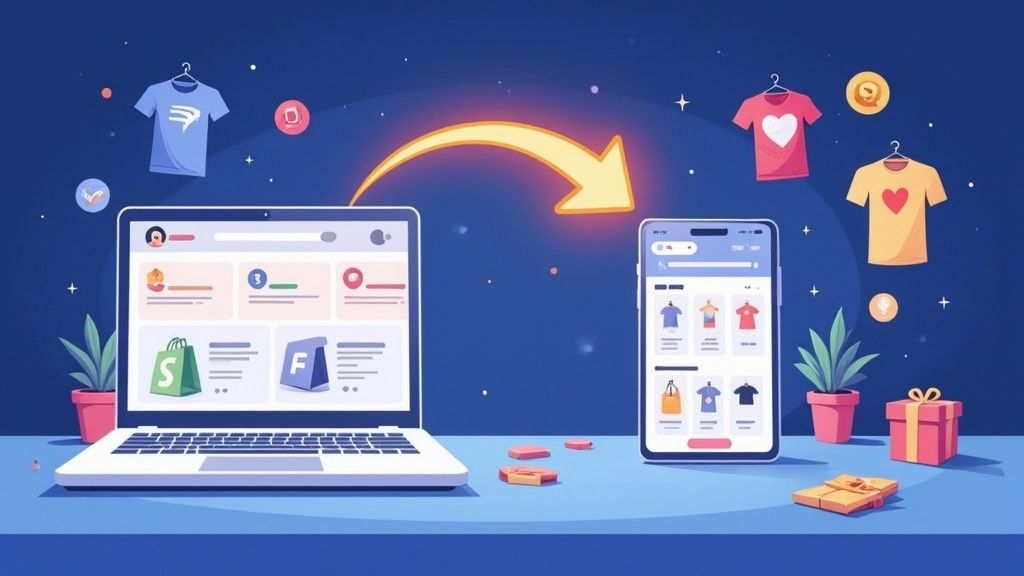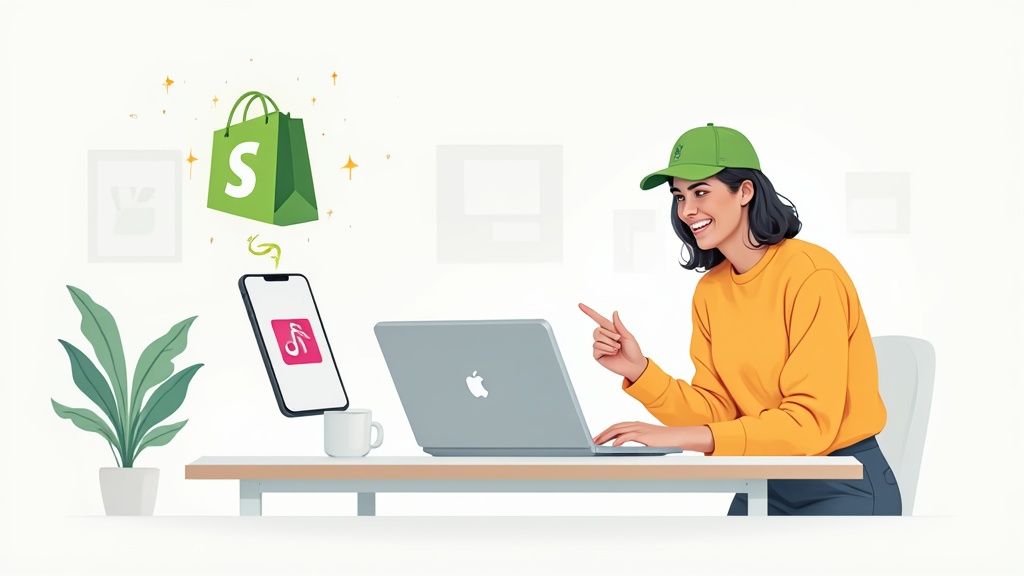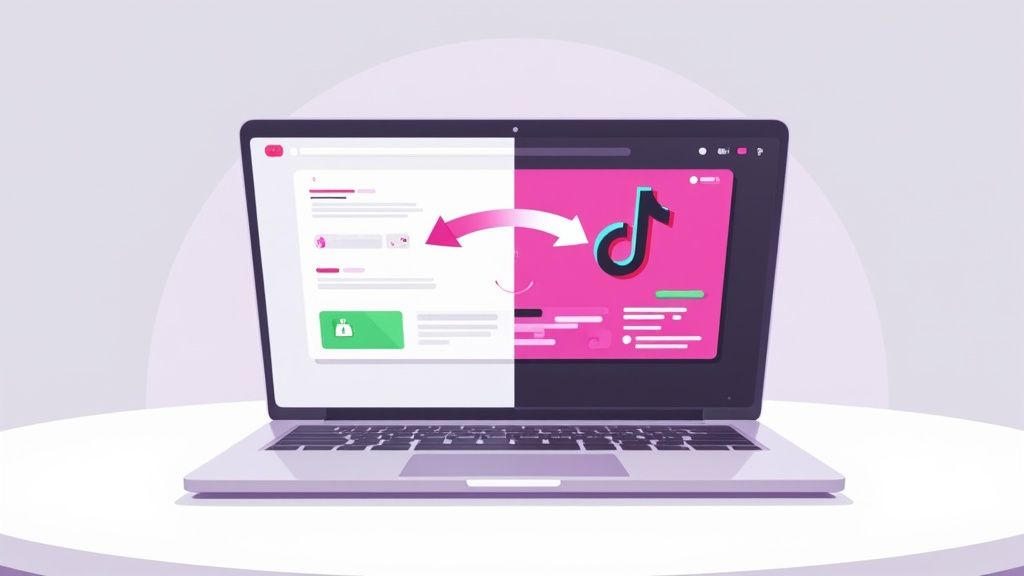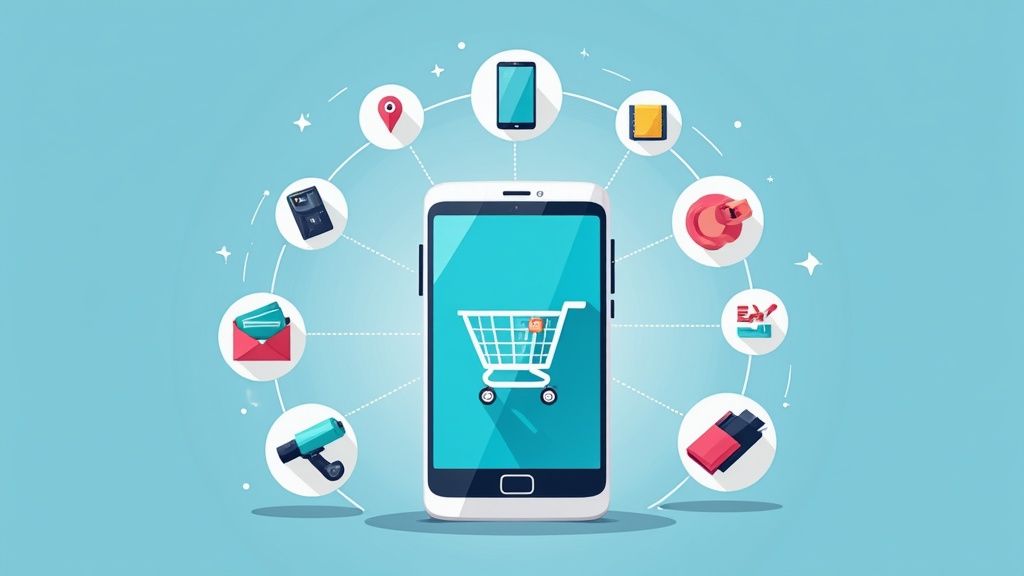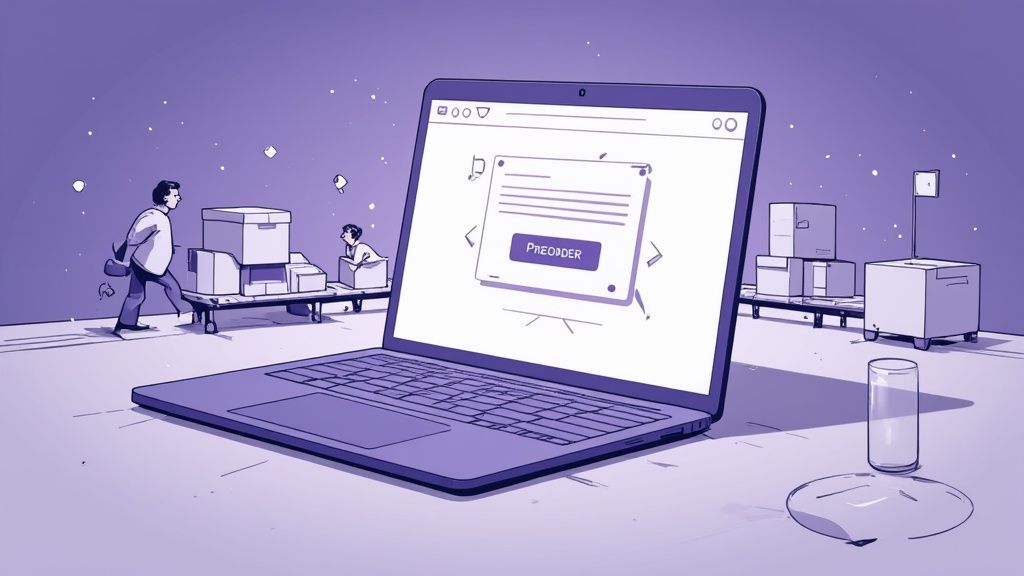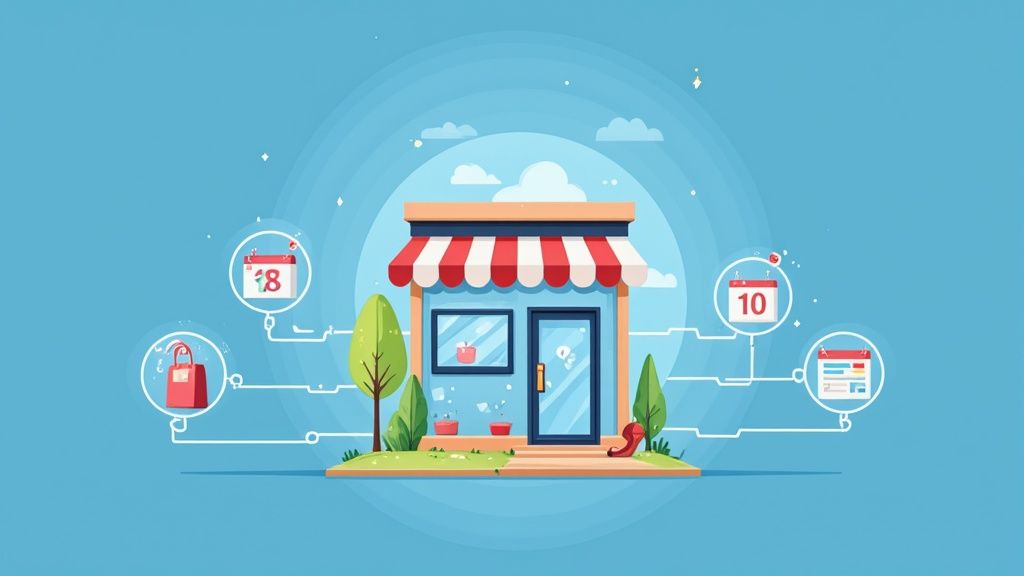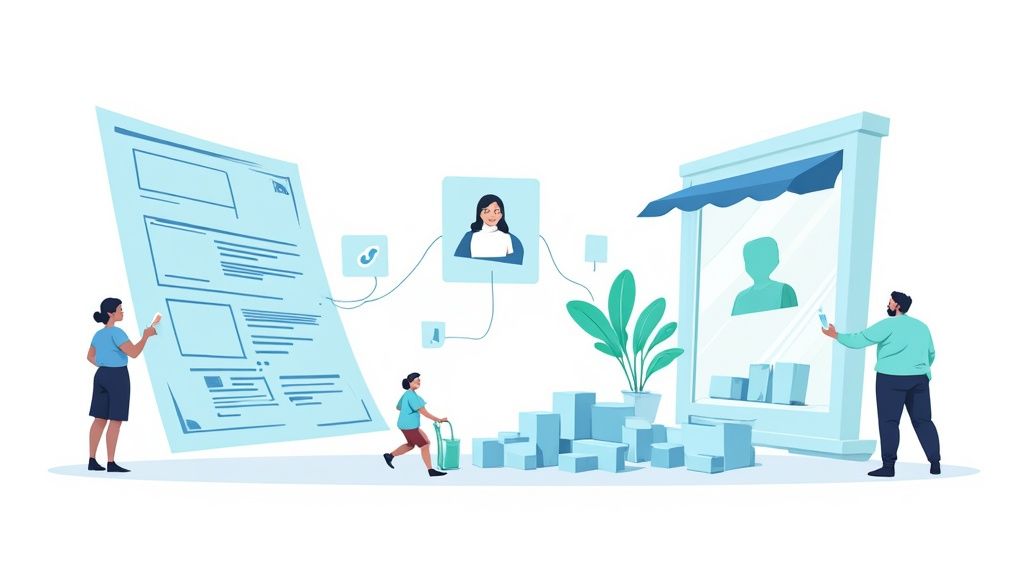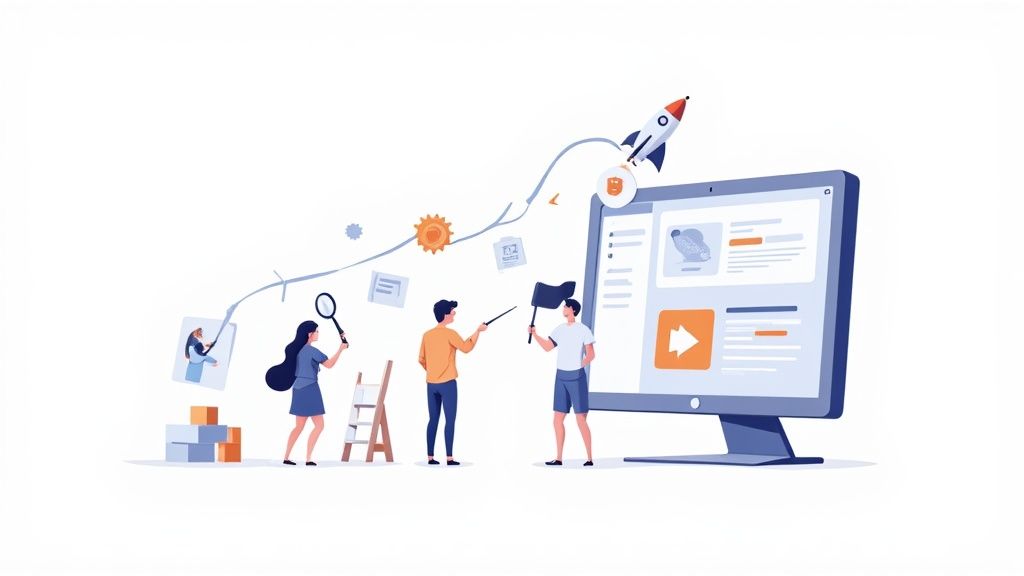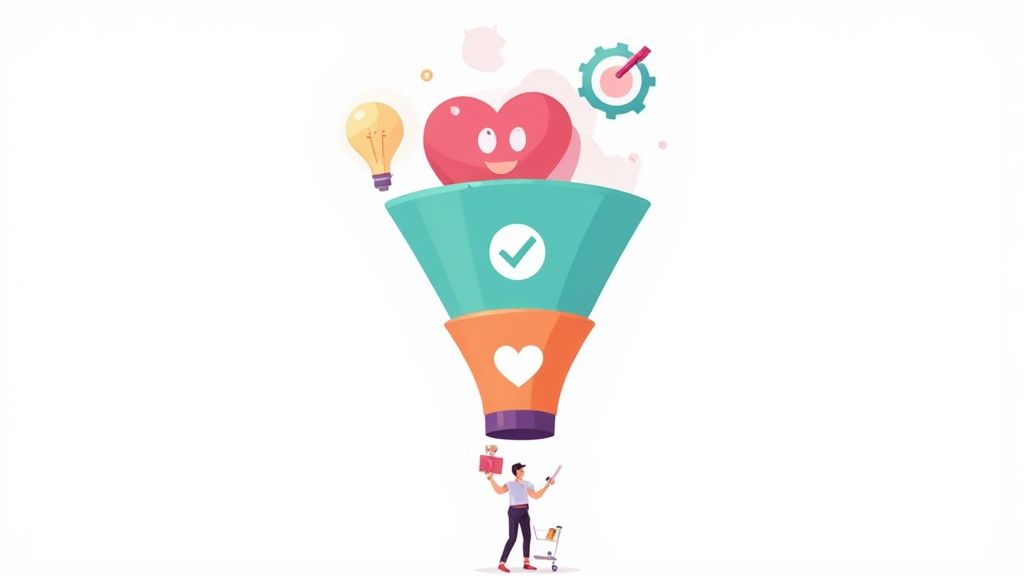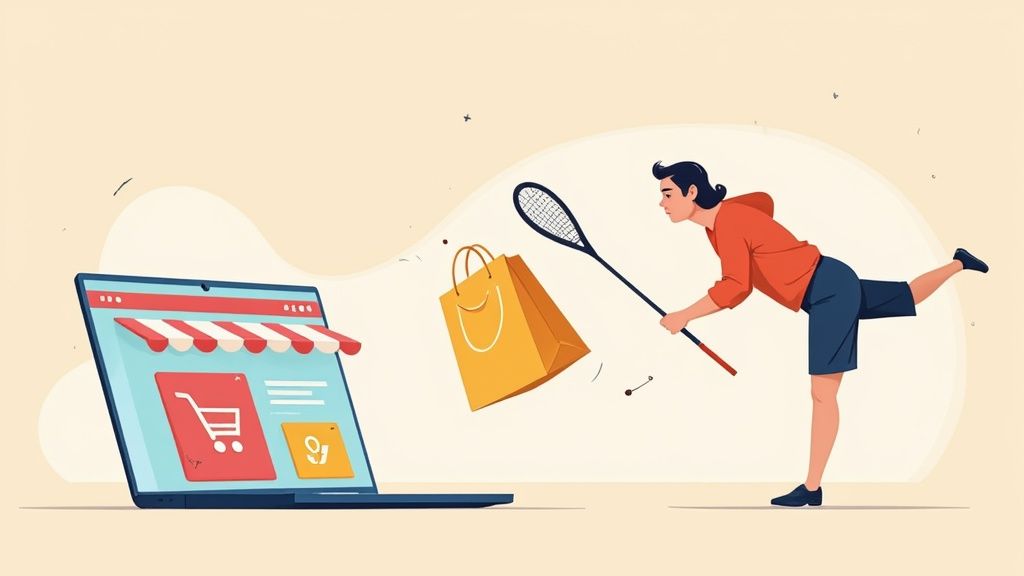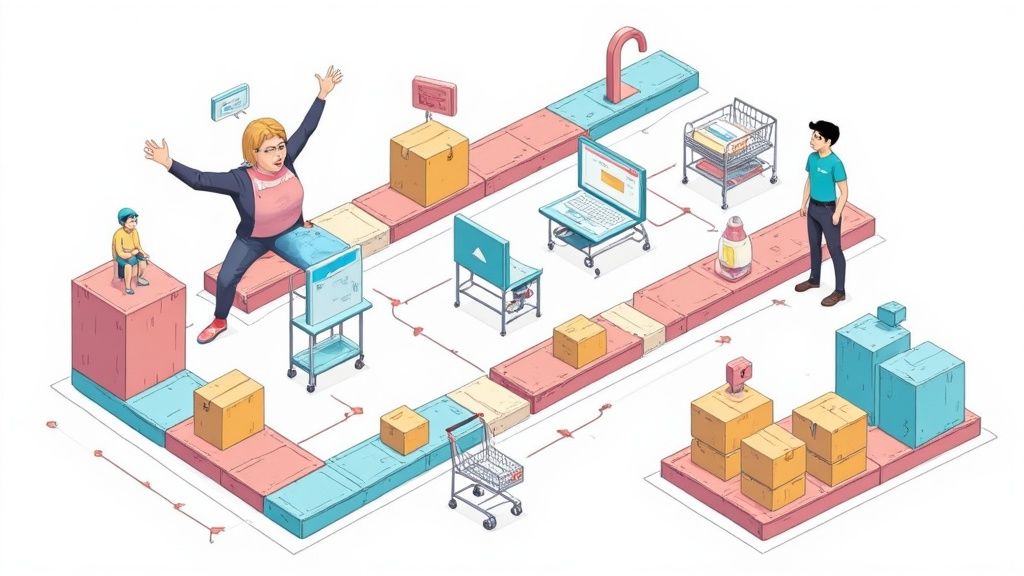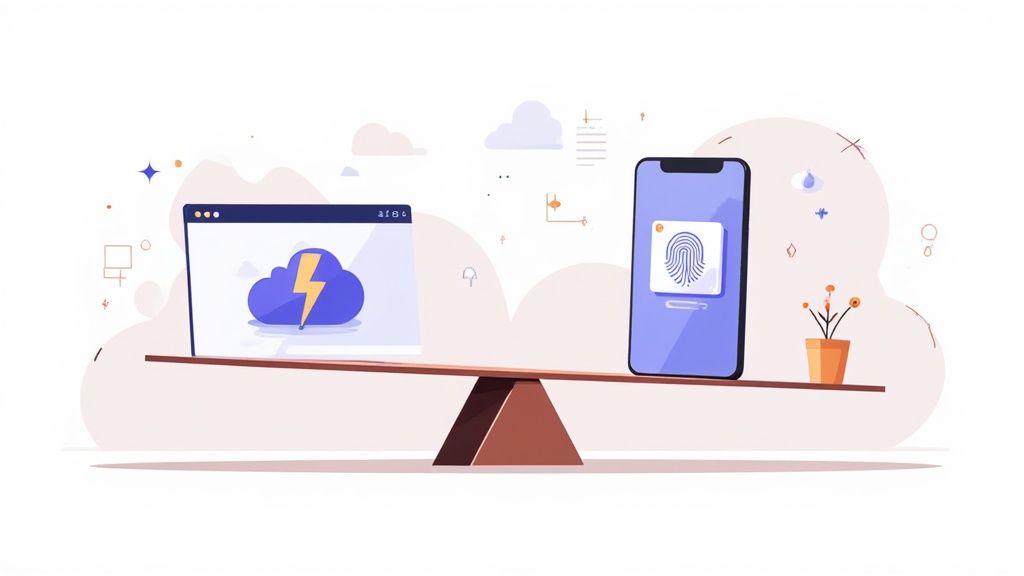
Trying to scale your ecommerce business by just throwing more money at ads or cramming more products onto your site is a recipe for disaster. Real, sustainable growth comes from building a resilient foundation—one that can actually handle an explosion in demand without cracking under the pressure. It’s about reinforcing your operations before you slam your foot on the accelerator.
Building Your Foundation for Sustainable Growth
I've seen it happen too many times: a brand goes viral or a campaign wildly overperforms, and their newfound success becomes their downfall. That sudden surge in orders is like a stress test, and it will mercilessly expose every single weakness in your operations. The result? Frustrating shipping delays, embarrassing stockouts, and a brand reputation that takes a nosedive.
So, before you even think about scaling, you need to conduct a brutally honest audit of your core infrastructure.
This isn't the glamorous part of ecommerce. It's not about slick marketing campaigns or record-breaking sales days. It's about stability. Think of it like building a skyscraper—you wouldn’t start framing the 50th floor without being absolutely certain the foundation could support the weight. Your supply chain, your customer service team, and your fulfillment process are your foundation.
This graphic breaks down the essential flow. You start with a clear-eyed assessment, implement the right tech and processes, and then expand your reach.

It’s this foundational work that positions you to grab a bigger piece of the pie. And that pie is getting bigger every year.
The global shift to online shopping is undeniable. By 2025, ecommerce is on track to account for 20.5% of all retail sales, and that number is expected to hit 22.5% by 2028. With more than 2.77 billion people shopping online, a rock-solid foundation means you can reliably serve this massive, growing customer base.
Auditing Your Operational Readiness
A real audit is more than a quick glance at your sales dashboard. It’s an honest, deep dive into the parts of your business that will feel the most strain when growth hits. The goal here is to spot the bottlenecks before they become full-blown catastrophes.
Start with your supply chain. Do you have backup suppliers lined up? What are their lead times? Can they realistically handle a 3x or 5x increase in your order volume? A single point of failure here can bring your entire business to a grinding halt.
Next, look at your customer service. If your support inbox is already a chaotic mess, imagine what it will look like when order volume doubles or triples. Your team will be completely swamped, leading to agonizingly long response times and angry customers.
The key thing to remember is that your brand promise is only as strong as your ability to deliver on it. Scaling has a way of magnifying every tiny crack in your operations, turning minor hiccups into major problems that destroy customer trust.
Finally, scrutinize your fulfillment process. Whether you pack boxes in-house or use a 3PL, can it actually manage a sudden spike in daily shipments? I once saw a boutique go viral on TikTok, jumping from 50 orders a day to 5,000 overnight. Their small, in-house team was completely crushed. It led to two-week shipping delays and a flood of negative reviews that instantly tarnished their moment in the spotlight.
Preparing Your Infrastructure for Expansion
Once you’ve identified your weak spots, it’s time to shore them up. This isn’t about over-investing; it’s about making smart, strategic upgrades. Diving into these 10 effective ecommerce growth strategies can give you a clear roadmap for what comes next.
Ready to see how prepared you are? Use this self-assessment to get an honest look at your business.
Growth Readiness Self-Assessment
Use this checklist to honestly evaluate your business's readiness to scale across key operational areas.
This checklist isn't just a to-do list; it’s a proactive plan to prevent growing pains from becoming business-ending emergencies.
Here are a few practical steps you can take right now to reinforce your operations:
- Diversify Your Supplier Base: Don't just find a backup—build a relationship. Securing at least one alternate supplier for your bestsellers builds resilience and gives you negotiating power.
- Invest in Customer Service Tools: A good helpdesk system organizes tickets and automates replies to common questions ("Where is my order?"). This frees up your agents for the complex issues that truly require a human touch.
- Stress-Test Your Fulfillment: If you're in-house, run a drill. See how many orders your team can accurately pick, pack, and ship in a single day. If you use a 3PL, have a candid conversation about their peak season capacity and service-level agreements (SLAs).
Taking these steps isn't about slowing down. It's about building a framework that supports your growth ambitions instead of being crushed by them. This is how you scale sustainably and keep your customers happy along the way.
Optimizing Your Digital Storefront for Conversion
 Think of your website as your star employee. It works 24/7, greets every single visitor, and is ultimately the one responsible for closing the sale. As you start pouring more traffic into your ecommerce business, that storefront needs to be a well-oiled machine, converting visitors with ruthless efficiency.
Think of your website as your star employee. It works 24/7, greets every single visitor, and is ultimately the one responsible for closing the sale. As you start pouring more traffic into your ecommerce business, that storefront needs to be a well-oiled machine, converting visitors with ruthless efficiency.
This is where Conversion Rate Optimization (CRO) and User Experience (UX) stop being buzzwords and become your most important growth levers. Too many brands fall into the trap of just buying more ads to scale. The real secret? Get more value from the traffic you already have. A smooth, intuitive user journey is the most direct path to boosting your profits.
The Psychology Behind a High-Converting Design
Great design isn't just about making things look good—it's about influencing behavior. It uses psychology to build trust and eliminate friction, making the path from browsing to buying feel natural and secure.
Take a hard look at your product pages. Are they just a dry list of features, or do they tell a story that connects with your customer's needs? A skincare brand isn't selling "moisturizer with hyaluronic acid." They're selling "the confidence of dewy, hydrated skin." Your design needs to deliver on that promise.
Here's what that looks like in practice:
- High-Quality Visuals: Use large, professional photos and videos. Show your product from every angle, in context, and on different body types if you're selling apparel.
- Clear Value Propositions: The moment a visitor lands, they should know "What is this?" and "Why should I care?" Be direct and lead with the benefits.
- Social Proof: Nothing sells like social proof. Make sure your star ratings, customer reviews, and testimonials are front and center. People trust other shoppers more than they'll ever trust you.
Pinpoint Friction with Advanced Analytics
You can't fix a problem you can't see. To really dial in your site's performance, you have to go beyond basic analytics and play detective. This is where tools like heatmaps and session recordings become your best friends.
Heatmaps give you a visual breakdown of where users click, move their mouse, and how far they scroll. Are they trying to click on something that isn't a link? Are they completely ignoring your main call-to-action? This data is pure gold.
Session recordings are even more insightful. You're literally watching a video of a user's journey on your site. You can see them get stuck, rage-click in frustration, or bail on their cart at the last second. It's the closest you'll ever get to looking over their shoulder.
I once worked with a brand that had a massive 40% drop-off on their checkout page. We couldn't figure it out until we watched the session recordings. It turned out a poorly designed discount code field was confusing users on mobile. A simple design change to make the field more obvious boosted their overall conversion rate by 12% in a single week.
Of course, driving qualified visitors to your site is the first part of the puzzle. An effective ecommerce SEO strategy is what gets them in the door; CRO is what convinces them to stay and buy.
A/B Testing: Your Path to Higher Revenue
Once you've spotted those friction points, it's time to test your solutions. A/B testing is the engine that powers CRO. Forget testing minor button color changes; focus on meaningful tests that can actually move the needle on revenue.
Some high-impact areas to start testing include:
- Product Page Layouts: Try different arrangements of your images, descriptions, and CTAs. What happens if you add a "sticky" Add to Cart button that follows the user as they scroll?
- Checkout Flow: Can you simplify the process? Test a single-page checkout against your current multi-step flow. Every field you can remove is a potential win.
- Offer Presentation: The way you frame a deal matters. Test "20% Off" vs. "$10 Off" or "Free Shipping" against an equivalent discount.
The goal is to build a culture of constant improvement. Every test—win or lose—teaches you something valuable about your customers. This cycle of spotting friction, forming a hypothesis, and testing a fix is how you build a powerful digital storefront that can handle massive scale.
Streamlining Your Operations and Supply Chain

As your eCommerce business starts to take off, the real stress test happens behind the scenes. Your backend—everything from operations and logistics to inventory—is where small cracks can quickly turn into catastrophic failures. A system that humming along nicely for 50 orders a day will completely buckle under the pressure of 500.
Growth isn't linear; it multiplies complexity. If your operational engine isn't built for the load, it will seize up, and your customer satisfaction will plummet right along with it.
The goal here is to build a system that can absorb a sudden surge in demand without even flinching. That means finally ditching the spreadsheets and manual data entry for smart automation and strategic partnerships. A solid supply chain isn't just about moving products faster; it's about building resilience and keeping the promises you make to your customers as you grow.
Taming Inventory with Smart Systems
Poor inventory management is a silent profit killer. It's a double-edged sword: stockouts mean lost sales and annoyed customers, while overstocking ties up your cash in products that are just collecting dust. Once you start growing, guessing games are no longer a viable strategy. This is where an Inventory Management System (IMS) becomes non-negotiable.
A good IMS syncs with your storefront in real time, giving you a crystal-clear picture of what you have and where it is. But the real magic is in its forecasting ability. By crunching historical sales data, it helps you predict future demand, which is an absolute game-changer for seasonal products.
Imagine you sell outdoor gear. An IMS could analyze last winter's scarf sales to forecast demand for a new line of beanies you're launching. This allows you to set automated reorder points, ensuring you’re never out of your bestsellers during peak season but also not stuck with a mountain of winter hats in July.
Choosing the Right Fulfillment Partner
There comes a point when packing boxes in your garage (or the back of your office) just doesn't cut it anymore. It's a time-suck, pulling you and your team away from what really moves the needle—marketing, product development, and customer engagement. This is the moment to seriously consider a third-party logistics (3PL) partner.
A 3PL takes the entire fulfillment headache off your plate: warehousing, picking, packing, and shipping. They bring professional expertise, heavily negotiated shipping rates, and often a network of warehouses that can get your products closer to customers, slashing delivery times and costs.
But not all 3PLs are created equal.
Don’t just look at the price per pick. A cheap 3PL that constantly messes up orders will cost you infinitely more in the long run through returns, angry emails, and a trashed reputation. Your 3PL is an extension of your brand—choose them as carefully as you would a key employee.
When you're vetting potential partners, dig into these factors:
- Technology Integration: How smoothly does their system plug into your Shopify store? Ask for a demo, not just a promise.
- Scalability: Can they handle your Black Friday volume without breaking a sweat? Request case studies from brands your size or slightly larger.
- Specialization: Do they have experience with your product type? Handling fragile glassware is a world away from shipping t-shirts.
- Return Management: What does their returns process look like? A clunky, slow returns experience can poison a customer relationship for good.
Automating the Order-to-Delivery Journey
The more manual steps you have between "checkout" and "delivered," the more chances there are for human error. Automation is your best weapon for stamping out these mistakes and freeing up your team's brainpower. A tightly integrated system can automate the entire journey from the second a customer clicks "buy."
This looks like automatically zapping order info to your IMS or 3PL, printing the right shipping labels based on preset rules, and firing off shipping notification emails to the customer without anyone lifting a finger. It's not just about being more efficient; it dramatically improves the customer experience with timely, accurate updates.
Think about the ripple effect of these seemingly small automations:
By building these automated processes, you create a robust machine that doesn't depend on one person's memory or a specific spreadsheet. This operational backbone is what gives you the confidence to truly scale your ecommerce business, knowing your fulfillment can handle whatever your marketing team throws at it.
Harnessing AI and Automation to Work Smarter

If you want to truly scale an eCommerce business without just throwing more people at the problem, you have to get smarter. This is where technology comes in, handling the repetitive, data-heavy tasks that eat up your team's day. It's not about replacing your talented people; it’s about freeing them up to focus on strategy, creativity, and the big-picture moves that drive growth.
Artificial Intelligence (AI) and automation are the twin engines that power this efficiency. And forget the idea that you need a Ph.D. in data science to make it work. Today’s tools are surprisingly accessible, letting you build sophisticated systems that improve personalization, boost efficiency, and ultimately create a much better experience for your customers.
Moving Beyond Basic Chatbots
When most people hear "AI in eCommerce," their minds jump to the simple chatbots that answer FAQs. That’s a start, but it barely scratches the surface of what’s possible. The real magic happens when you use AI to analyze oceans of data and make intelligent decisions faster than any human team ever could.
Think about an AI-powered product recommendation engine. It goes way beyond just showing "customers also bought." It digs into an individual's browsing habits, purchase history, and even what similar shoppers are buying to serve up hyper-relevant suggestions on the fly. This kind of deep personalization can have a massive impact on your average order value.
A key insight is that AI excels at identifying patterns in vast datasets. For a growing store, this means it can predict which customers are likely to churn, what products will be in high demand next month, and even the optimal price for a new item.
Another powerful application is dynamic pricing. AI can keep an eye on competitor prices, your own inventory levels, and customer demand to adjust prices automatically. During a flash sale, for instance, it can tweak discounts to maximize revenue without sacrificing too much margin.
Automating the Repetitive Work That Slows You Down
Automation is the absolute backbone of operational efficiency. Its job is to take over the predictable, rules-based tasks that are critical but incredibly time-consuming. This lets your team focus on solving complex problems and building real relationships with customers.
Here are a few high-impact areas where automation can make a huge difference:
- Fraud Detection: AI algorithms can scan thousands of data points for every single transaction, flagging sketchy orders with incredible accuracy and protecting your bottom line.
- Customer Service Triage: An automated system can instantly read and categorize incoming support tickets, routing them to the right agent and bumping urgent issues to the front of the line.
- Marketing Workflows: Set up automated triggers for personalized email and SMS campaigns based on customer behavior. Think abandoned cart reminders, post-purchase follow-ups, or win-back campaigns.
Choosing the Right Tools for the Job
Getting these systems up and running is more straightforward than you might imagine. Many tools are designed to integrate seamlessly with major platforms like Shopify, offering a nearly plug-and-play experience. When you're ready to dig deeper, our guide on how to use AI in ecommerce is a great resource for specific tools and strategies.
To truly work smarter, you can also apply automation to your communication channels. For example, implementing powerful WhatsApp marketing automation strategies lets you nurture leads and support customers with personalized, timely messages right on their phones.
The core principle here is simple: find the manual tasks creating bottlenecks in your business and apply technology to break through them. Start small. Identify the single most repetitive task your team does—whether it’s tagging support tickets or updating inventory spreadsheets—and find a tool to automate it.
Each small automation you add compounds over time, building a more resilient, efficient, and scalable operation. This is how you build a business that can handle a 10x jump in order volume without needing a 10x increase in headcount. It’s how you scale your ecommerce business for whatever comes next.
Expanding Your Market Reach and Going Global
So, you've found your groove. Sales are steady, and your home market is humming along nicely. What's next? For many brands, this is the exact moment to start thinking bigger. The next logical step to truly scale your ecommerce business is to look beyond your current borders. This could be as simple as tapping into new regions of your own country or as ambitious as taking your brand international.
Going global is about so much more than just ticking a box for "international shipping." It’s a serious strategic move. You have to get inside the heads of entirely new customer groups, wrap your head around different regulations, and localize your brand so it feels as natural in Berlin as it does in Boston. The prize is massive, but the path requires careful planning.
The sheer scale of the global opportunity is hard to ignore. When you’re mapping out your strategy, you have to know who the big players are. Projections for 2025 put China at the top of the ecommerce food chain with an estimated market value of $3.45 trillion. The United States follows at $1.38 trillion. These aren't just giant pools of revenue; they're the markets setting trends for the rest of the world.
Conducting Smart Market Research
Before you even think about planting a flag in a new country, you've got to do your homework. Trust me, launching into a market you don't understand is one of the fastest ways to burn through capital and damage your brand. The first step is always solid, intelligent research to find out where the real opportunities lie.
You need to go deeper than just looking at a country's GDP. You have to understand the local consumer psyche.
- Payment Preferences: We take credit cards for granted in North America, but that's not the case everywhere. In Germany, bank transfers are a big deal. In the Netherlands, iDEAL reigns supreme. If you try to force your payment methods on a new market, you can kiss your conversion rates goodbye.
- Product-Market Fit: Will people actually want what you're selling? A bestseller in the US might be a total flop in Japan because of cultural norms or strong local alternatives. Use tools like Google Trends and watch social media conversations in your target country to see if there's any buzz around your product category.
- Regulatory Hurdles: This is the boring but critical stuff. Every country has its own jungle of rules for taxes (like VAT), import duties, and product safety. It’s a pain to navigate, but ignoring it can lead to legal nightmares and shipments getting stuck at the border.
Localization, Not Just Translation
This is probably the single biggest mistake I see brands make. They run their website through a translation tool and think they're done. True localization is so much more than that. It’s about tailoring the entire customer experience to feel completely native. This is a non-negotiable part of any real growth plan, which we cover in our complete guide on how to scale your ecommerce business.
Think about it like this: translation changes the words, but localization changes the feeling.
A successful international launch makes foreign customers feel like you’ve been a beloved local brand for years. It’s about building trust and connection by showing you understand and respect their culture, not just their currency.
A US-based apparel brand I know learned this lesson well when expanding to Europe. They didn’t just translate their site. They hired local models for their photoshoots, adjusted their sizing charts to match European standards, and built marketing campaigns around local holidays. That level of detail made them feel authentic, and it paid off with strong initial sales.
Navigating Cross-Border Complexities
Finally, you have to get practical and figure out the logistics. Getting a package from your warehouse to a customer's doorstep thousands of miles away is a different ball game.
Expanding your market is a powerful growth engine. It’s not easy, but by doing the research, investing in real localization, and choosing the right partners to handle the logistics, you can open your brand up to a whole new world of customers.
Frequently Asked Questions About Scaling an Ecommerce Business
When you're on the verge of major growth, it’s completely natural for questions and a bit of uncertainty to creep in. The road to scaling your eCommerce business is paved with big decisions. Getting the timing, logistics, and overall strategy right is what separates sustainable expansion from absolute chaos.
Let's dive into some of the most common questions we hear from founders just like you.
When Is the Right Time to Scale My Ecommerce Business?
The perfect time to scale isn't about one viral moment or a surprisingly good sales month. Real readiness is all about stability and predictability.
You're likely in the zone when you've achieved consistent profitability, not just fluctuating revenue. Another massive signal is having a solid product-market fit, which you can see in a healthy customer lifetime value (LTV) and customers coming back for more.
Before you slam the accelerator, do an honest check of your operations. Can your current supply chain and fulfillment setup comfortably handle a 2-3x spike in orders for a sustained period? If your customer service team is already drowning, scaling will just burn them out and tank your reputation. Look for steady growth trends over several months, not just a one-off success.
Should I Use a 3PL or Manage Fulfillment In-House When Scaling?
This really comes down to your order volume, how complex your products are, and the capital you have on hand.
Keeping fulfillment in-house gives you total control over the customer experience and branding. But it’s a beast that demands huge investments in warehouse space, staff, and technology. It can quickly pull your focus away from what actually grows the business.
A third-party logistics (3PL) partner, on the other hand, brings expertise, established carrier relationships (hello, discounted shipping rates), and often a network of warehouses to get products to customers faster. For most growing brands, this is the more scalable and cost-effective path.
A good rule of thumb? Start seriously looking into a 3PL once you're consistently shipping over 100 orders a day. At that point, the time and money you pour into in-house fulfillment usually stop making sense.
What Are the Most Common Mistakes to Avoid When Scaling?
Scaling successfully is just as much about sidestepping common pitfalls as it is about making smart moves. Knowing what trips other brands up is your first line of defense.
Here are the biggest mistakes we see time and time again:
- Scaling Too Quickly: The classic blunder. Founders get a taste of rising sales and go all-in before their operational foundation is solid. This almost always leads to fulfillment nightmares and a damaged brand.
- Ignoring Profitability for Revenue: Chasing top-line growth by overspending on customer acquisition is a dangerous, cash-burning game. If your unit economics are broken, scaling just means you lose money faster.
- Neglecting Technology Investment: You can't run a complex, growing business on spreadsheets and manual workarounds. Failing to invest in a proper inventory management system or a real helpdesk will create bottlenecks that choke your growth.
- Losing Touch with Customers: As you get bigger, it's easy to get lost in data dashboards and lose that connection to the customer feedback that got you here in the first place. Never let analytics replace genuine conversations with your community.
At ECORN, we specialize in building the robust, scalable Shopify experiences that growing brands need. From CRO that turns traffic into revenue to expert development that prepares your store for any challenge, we provide the flexible solutions to power your expansion. Explore our subscription packages and see how we can help you scale with confidence.






